

Visit Japan Web: The Online Registration Before Arriving in Japan
Japanese customs: mysos replaced from november, 14, 2022.
During the Covid pandemic, entry procedures in Japan have changed a lot, which created some confusion. It is still somewhat the case after the reopening to tourism since October 11, even if a focus has been placed on easing the procedures especially through digitalization , to minimize human interactions and subsequent contamination risks.
Until recently, the Japanese government asked visitors to install specific app on their smartphones:
- MySOS, for advance registration of information regarding vaccine status / PCR test, for faster airport procedures in Japan (the "fast track" system)
- COCOA, an app to track contact-cases and infected persons, but it was discontinued in September 2022.
MySOS was not mandatory but highly recommended . Travelers who could not use the app were directed upon their arrival in Japan to a specific line in order to complete the necessary steps (showing a valid vaccination certificate / PCR test, etc.) which lengthened their time at the airport.
New website available since November 1st, 2022
In mid-October 2022, a new change in the procedure has been announced for all entry in Japan from November 14 included : every traveler (tourist, foreign resident and Japanese citizen alike) can register in advance on the Visit Japan Web site.
Visit Japan Web is a free, single portal to group formalities related to:
- Covid-19 🦠 ( quarantine , vaccination certificate, PCR test); The Pre-registration for Quarantine Procedures section collects the information that were previously filled in the MySOS app ("Fast Track" function);
- Immigration : the Disembarkation Card for Foreigner that was formerly handed in the plane ✈️ just before landing (does not concern Japanese citizens and foreign permanent residents);
- Customs 🛂 , with the Declaration of Personal effects and Unaccompanied Articles , to fill upon arrival, formerly either on a paper form or on the Japanese government’s Zeikan shinkoku app (税関申告アプリ).
In the facts, registering on the website has been possible since November 1, 2022 , for any arrival in Japan from November 14 in one of its largest airports:
- Tokyo -Narita,
- Tokyo-Haneda,
- Osaka - Kansai (KIX),
- Chubu ( Nagoya ),
- Fukuoka ( Kyushu ),
- New Chitose ( Hokkaido ) and
- Naha ( Okinawa ).
Travelers arriving in Japan before November 14, 2022, can still use the MySoS app to fill their Covid related data and are not the target of the Visit Japan Web.
1 blue screen and 2 QR Codes to show on a smartphone
Like with MySOS previously, each step of the registration process is ended by a change in the page display that includes:
- A blue screen , for a successful quarantine procedure registration,
- and the creation of 2 QR Codes for customs and immigration procedures.
Once all the steps are completed, a visitor’s smartphone 📱 will display first a blue screen, then 2 QR Codes to show at each checkpoint.
Starting April 29, 2023 , according to March 10 and April 26 latest announcements of the Ministry of Health, Labor and Welfare, some of the borders restrictions will be lifted and the Covid-19 quarantine procedure (blue screen) will not be required anymore .
It is highly recommended to register before departing for Japan : at the latest 6h prior to the flight’s departure, and ideally within the 10 preceding days , in order to allow time for the review of the submitted documents. Reviews are sorted by date of arrival in Japan . Visit Japan Web is available in English.
Whether you are fully vaccinated or not, consider using Visit Japan Web to make sure to board your flight to Japan, as airlines reserve the right to refuse passengers who may potentially be banned at the Quarantine Procedures step.
The necessary documents are:
- A valid email address (will be used as a user ID to each access to Visit Japan Web);
- Until April 29, 2023 , Covid vaccination certificate or negative PCR test result taken less than 72 hours before departure and translated in English (use the Japanese-English form provided by the Japanese Ministry of Health here );
- An address in Japan (for example, of the first accommodation you will be staying at).
If traveling with underage children , it is possible to register them on the same Visit Japan Web account (up to 10 travelers). Dependent or handicapped adults who cannot go through the procedures alone can also be registered in the Family members traveling with you section. However, each of them has to have their own passport or equivalent immigration document.
Each member of the family registered on the same account will also have their blue screen and 2 QR Codes, to show at checkpoints at the arrival airport in Japan.
Like with MySOS, registering with Visit Japan Web is not mandatory , however it helps going through the entry procedures in Japan faster, and reduces the hurdles of tedious formalities after 12 hours of more spent in a plane.
On April 5, 2023, Kono Taro, the Japanese Minister of Digital Affairs, announced that travelers are no longer required to show any document at arrival airport’s quarantine in Japan . However, filling information forms for immigration and customs is still a requirement.
Additional tips and advice
An Internet 📶 connection is required to use the Visit Japan Web site, especially to create the account, fill in the user’s information, and their family’s when applicable (name, passport number, etc.), the forms regarding vaccination or PCR test and create the first QR Code. The digital Disembarkation Card for Foreigners and custom procedures can be completed offline and the QR codes created upon arrival at the airport.
Creating a Visit Japan Web account is possible on a computer (Chrome browser is recommended) or on a smartphone (Chrome browser recommended on Android). In any case, before departure, make sure to be logged in only on the device you will use to travel (a smartphone ideally), and check that all information is up-to-date.
Questions asked at immigration and customs procedures are the same than on the paper forms. In any event, official Japanese sources (the Embassy of Japan or the Border Control page of the Japanese Ministry of Health for example) are the ultimate references regarding entry procedures in Japan and should be checked frequently.
- Flights and Airports
- Accommodation
- Transportation
- Internet & Phones
- Budget and money
- Japanese Food
- Visit with Kids
- Seasons: spring / summer / autumn / winter
- Weather forecast
- Time in Japan
- Holidays & Festivals
- Natural Disasters
- Customs and Duties
- Works and Closures
- September 21 -- Autumn starts in Japan
- September 23 -- Autumn Equinox (Shunbun no Hi - holiday)
- From October 9 to 10 -- Hachiman Matsuri (the Autumn Takayama Festival)
- October 22 -- Jidai Matsuri Festival in Kyoto
- October 29 -- Isao Takahata's birthday (born in 1935)
- October 31 -- Halloween in Japan
- Tokyo : Shinjuku , Shibuya , Harajuku , Asakusa , Akihabara , Odaiba , Ikebukuro , Ueno , Roppongi , Chiyoda , Ryogoku ...
- Around Tokyo: Kamakura , Nikko , Hakone , Mount Fuji , Mount Takao , Yokohama ...
- Kansai: Kyoto , Nara , Osaka , Mount Koya , Himeji , Kobe , Kinosaki , Kumano Kodo , Ise ...
- Japanese Alps: Kanazawa , Matsumoto , Takayama , Shirakawa-go , Nakasendo ...
- West: Hiroshima , Miyajima , Shikoku , Onomichi , Naoshima , Izumo , Kurashiki , Matsue ...
- South: Kyushu , Okinawa , Yakushima ...
- North: Hokkaido , Tohoku ...

- Temples and Shrines
- Gardens and Parks
- Hiking and Trekking
- Observation Decks
- Public Baths (Onsen and Sento)
- Festivals (Matsuri)
- Amusement Parks
- Visit on a Budget / Luxury

Keikaku is a travel agency specialist of Japan and providing different kind of services:
- Japan Rail Pass
- English speaking Guides
- Pocket Wi-fi
- Japan Nightlife
- Working in Japan
- Religion and Spirituality
- Arts and History
- Movies / Animated Movies
- Japanese Music
- Studio Ghibli
- Photos / Videos
- Weird Japan
- Translations
- Kana & Kanji
- Japanese Swear Words
- Honorific Suffixes (san, kun, chan...)
- Introducing yourself
- Thank you / Apologize
- Count / Say Your Age
- Say the Date / Tell the Time
- Happy birthday
- Enjoy Your Meal
- Writing your name

Kanas are the much-needed basic characters of written Japanese language. Memorize them at a fast pace with our method.

Ask any kind of question and share your knowledge about Japan in Kanpai’s community space, our Q&A section Kotaete.

Isshoni means "together" in Japanese: share your trip details (dates, places you would like to visit) and find companions to travel in Japan.

Create your Kanpai account to manage your profile and view your participation history (questions, answers).
Visa Traveler
Exploring the world one country at a time
Japan Visa for Tourists in 2024: A Comprehensive Guide
Updated: March 26, 2024
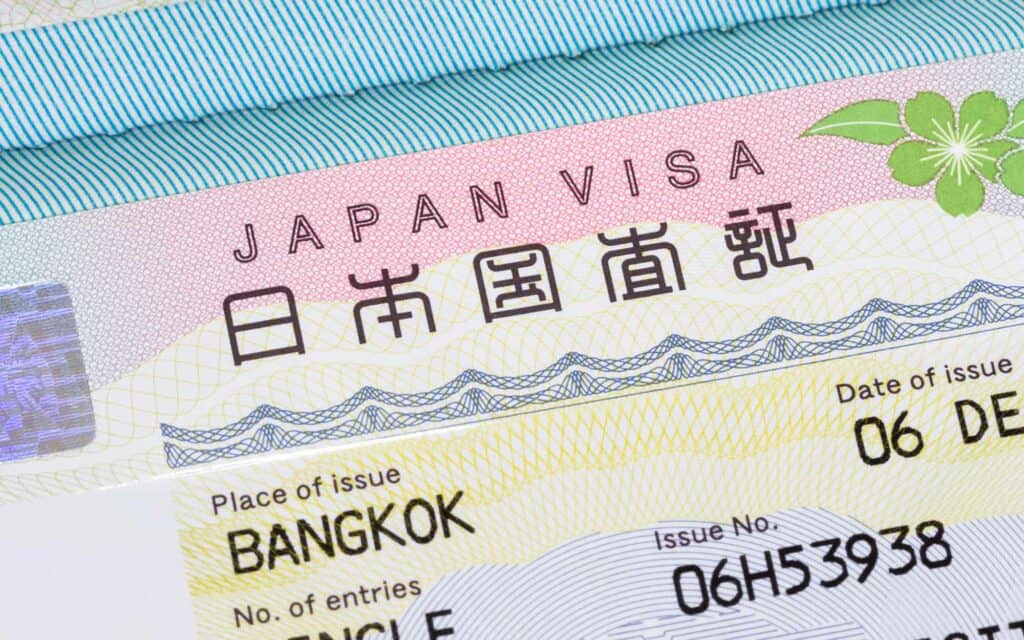
After being completely closed for tourism for more than 2 years, Japan finally reopened on October 11, 2022, restoring the previous visa exemptions and reducing the visa requirements.
Many nationalities are exempt from having to get a visa. Nationals and residents of select countries can obtain an eVisa online and everyone else can visit one of the over 200 embassies and consulates worldwide.
Table of Contents
Visa policy and visa types.
Nationals from 70 countries can travel to Japan visa-free . Most can stay up to 90 days.
Unless exempt, nationals and residents from 11 countries can apply for an eVisa online. They may still have to visit their nearest Japanese embassy. The eVisa allows stays for up to 90 days.
Everyone else must obtain a regular tourist visa from a Japanese overseas mission before traveling.
Japan does not have a visa on arrival.
Below is a summary of available visa types for tourists.
Entry Requirements
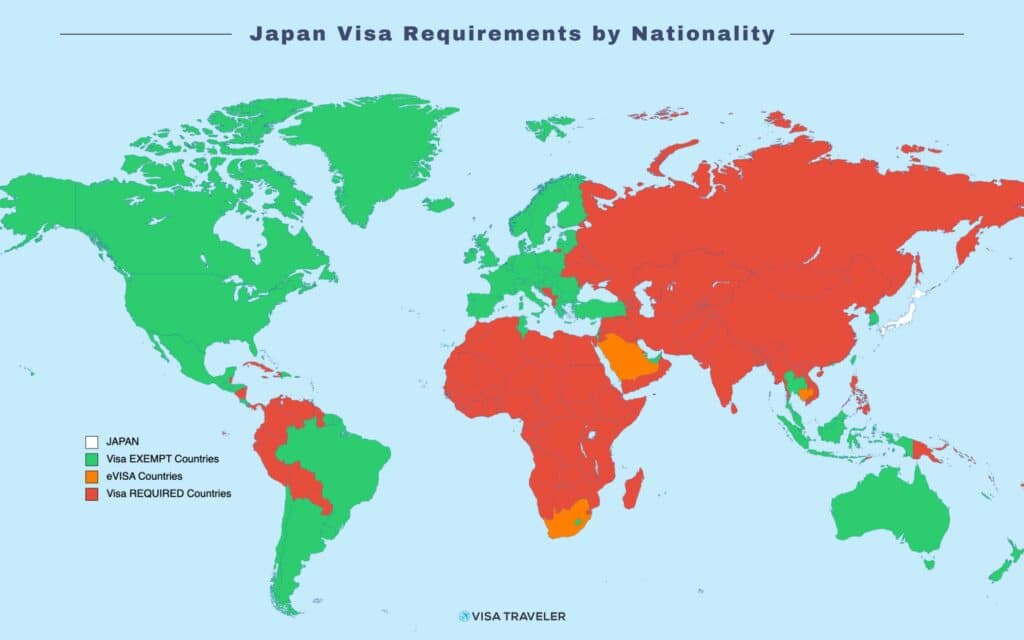
The following requirements apply to all visitors to Japan:
- Passport, which will remain valid during the period of stay
- Proof of sufficient funds to cover the cost of stay
- Return or onward ticket
Border officials rarely ask about the last 2.
For the specific visa requirements, see the corresponding section below.
Visa Exemption
Nationals of 70 countries are visa-exempted to travel to Japan. 65 countries are allowed to stay 90 days and the remaining 5 countries are allowed to say 14 to 30 days depending on the nationality.
There are additional requirements for some nationalities, outlined below. It’s best to check the official Japanese Foreign Ministry website for details.
- Austria (6)
- Barbados (5)
- Czech Republic
- Dominican Republic
- El Salvador
- Germany (6)
- Hong Kong (3)
- Ireland (6)
- Lesotho (5)
- Liechtenstein (6)
- Malaysia (2)
- Netherlands
- New Zealand
- North Macedonia
- South Korea
- Switzerland (6)
- United Kingdom (6)
- United States
- United Arab Emirates (2)
- Indonesia (1)
- Thailand (2)
- Must register an ePassport at a Japanese embassy in the respective country. Registration is valid for 3 years but not longer than the passport’s expiry date.
- Must have an ePassport, otherwise, need a visa.
- Only for passports issued by the corresponding Special Administrative Region.
- Must have a personal ID number.
- Must have a Machine-Readable Passport .
- Eligible to extend their stay to up to 6 months. Applications are made at a Regional Immigration Bureau inside Japan.
Japan eVisa
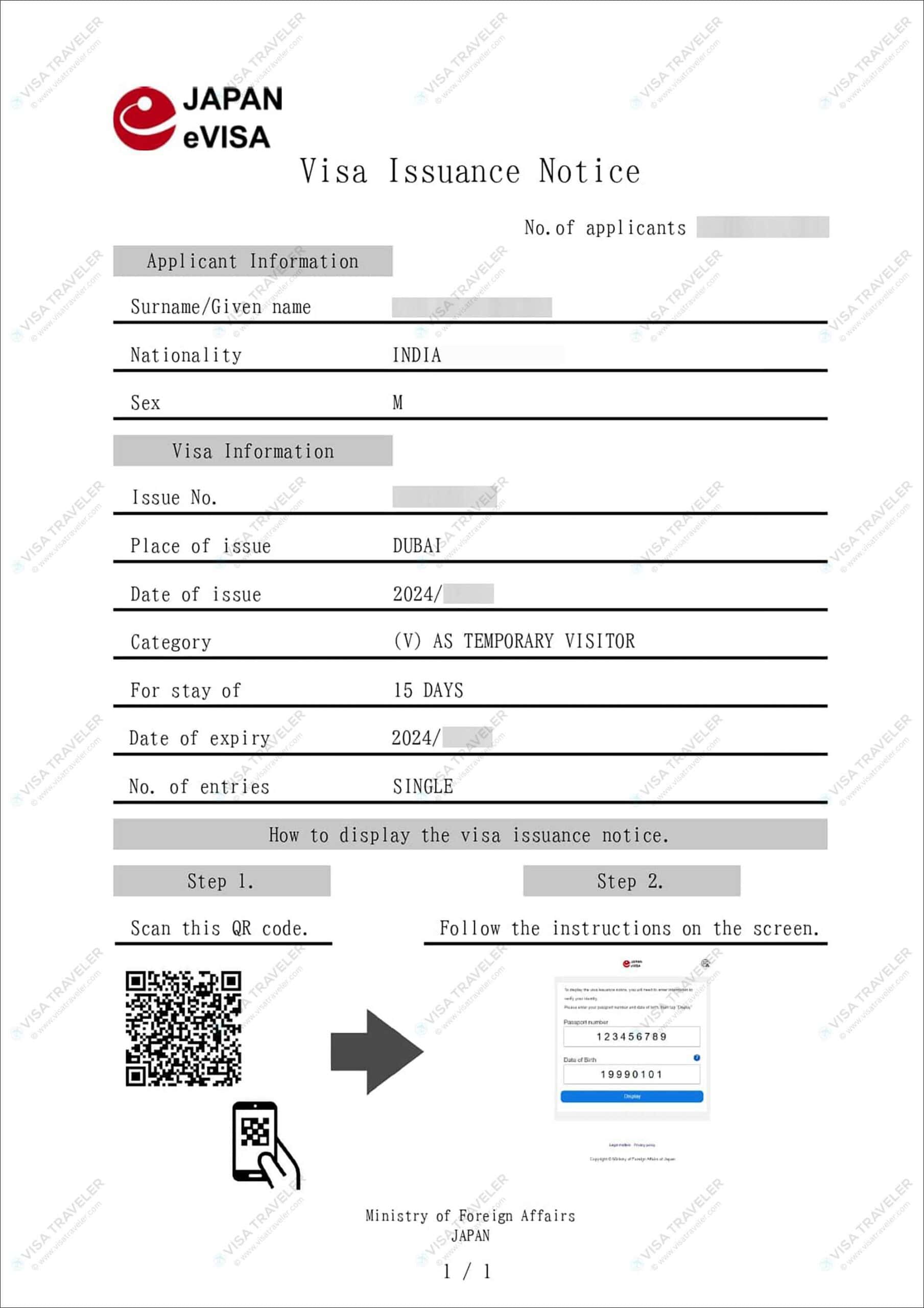
All nationals and residents from below 14 countries are eligible to apply for Japan eVisa. Those already visa-exempt don’t need to apply.
- Saudi Arabia
- South Africa
- United Arab Emirates
- United Kingdom
- Mongolia*
*Required to apply through an agency (see below).
Characteristics
- Only for tourism
- Valid for 3 months, single-entry only
- Duration of stay up to 90 days
- Fee 3,000 JPY or equivalent. Payable online or in person at the embassy. Some nationalities are exempt from the fee (check with your embassy)
- Processing takes 5 days to issue but could sometimes take longer
Documents required
What documents are required depends on your nationality and residence. These are the most commonly asked documents but check on the eVisa portal online for an exact list.
- Passport scan
- Color picture taken within the last 6 months
- Proof of immigration status (e.g. Permanent Residence Card or Visa if applicable )
- Flight itinerary (you don’t have to buy the tickets in advance, an itinerary from an airline is sufficient)
- Recent bank statement
- Travel itinerary (must be specific format, download eVisa travel itinerary template here)
- Proof of current residential address (e.g. driver’s license, state ID, utility bill, or lease agreement)
- Visa for the country you will visit after Japan (unless it’s your own country)
Application procedure
Applying online is incredibly simple. You can check out this video from Japan’s MOFA or follow the steps below.
- Go to Japan eVisa portal
- Register an account
- Fill out the application and upload the necessary documents
- Wait for your documents to be examined. You may be asked to submit additional documents. You will receive an email inviting you to pay when this step is complete.
- Pay online or in person
- After the eVisa has been issued, log in and make sure you can show the “ Visa Issuance Notice ” on your smartphone.
There’s no need to print any documents. On the contrary, you must show the visa on a digital device. Screenshots are not accepted either.
At the border, show the visa issuance notice with the QR code.
Once inside the country, you will receive an email saying your eVisa has expired. Don’t panic. This means you cannot use it to enter Japan again. You are allowed to stay up to 90 days inside Japan.
Applying from China, Vietnam, and Mongolia
Obtaining an eVisa for Japan in these three countries comes with special provisions.
EVisa is available to nationals of China who reside in China (excluding Hong Kong and Macau). You must apply through a Japan Visa Application Center or an accredited travel agency.
The eVisa grants entry to Japan for up to 30 days. Read more about it on the Japanese embassy in China website .
EVisa is available to nationals of Vietnam, who reside in Vietnam. You must book a packaged tour organized by a travel agency.
EVisa is available ONLY to foreign nationals who reside in Mongolia. You must apply at the Japan Visa Application Center (VAC) in Mongolia. Check with the Japanese embassy in Mongolia for more information.
Read the Japan eVisa article for more in-depth information on eVisa requirements, processing times, application process and border procedures.
Japan Tourist Visa
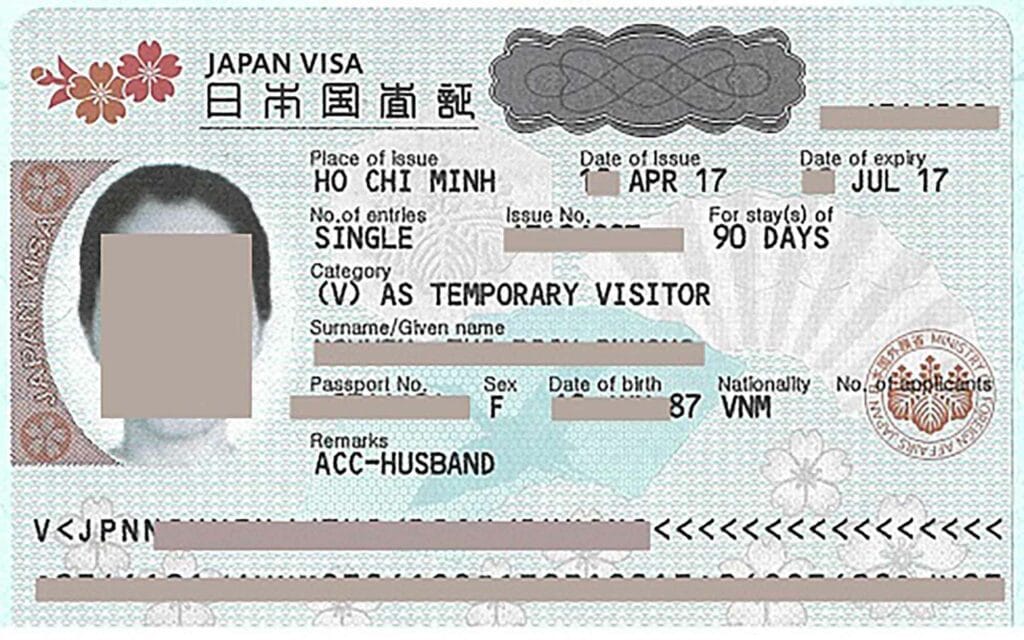
Everyone who’s not visa-exempt must obtain a visa to travel to Japan. If the eVisa isn’t an option, then you must obtain a tourist visa from a Japanese embassy.
Tourist visas are mostly single-entry. The term of stay can be either 15, 30 or 90 days from the date of entry. The visa itself is valid for 3 months for single entry and up to 5 years for multiple entry.
Requirements
The requirements for a tourist visa may differ depending on your nationality and the embassy you apply from. In most cases, they are:
- Passport with at least 2 blank pages
- Completed Visa Application Form
- 1 Passport-sized color photo taken within the last 6 months
- Flight itinerary
- Hotel reservation unless staying in an invitee’s home. It must cover the entire stay in Japan .
- Detailed, day-by-day itinerary in Japan .
- Most recent bank statement
- Proof of immigration status (if applicable)
The visa costs 3,000 JPY (~21$) or equivalent.
For further reading, check out the Japan Tourist Visa article for details such as when to apply, photo requirements and the application process.
Benefits of Japan tourist visa
Japan’s tourist visa is becoming a strong visa these days. That means Japanese visas have added benefits such as VISA-FREE travel to many other countries. As of 2024, you can travel to 14 countries with a Japanese visa. Read the VISA-FREE countries for Japan visa article for more details.
Transiting in Japan
Not leaving the airport.
If you are not already visa-exempt, you can transit in Japan without a visa only if:
- You stay within the international transit area of the airport;
- You have the necessary documents needed for the next country of destination;
- within 72 hours for Tokyo Haneda Airport or Kansai Airport (Osaka);
- within the same calendar day for all other airports.
Transit Visa
If you intend to pass through immigration and enter Japan for a short period, you must obtain a transit visa.
The requirements and procedures for obtaining transit visas are identical to regular tourist visas.
The main differences are in cost and duration of stay. The transit visa costs 700 JPY (~5$) and is issued for a maximum of 15 days but usually just 2-3 days until your next flight.
Japan Shore Pass
If you are transiting in Japan for less than 72 hours and you have a connecting flight that’s NOT on the same day, you may be able to obtain the Japan Shore Pass.
The application for it is usually done by the airline so it’s best to consult them.
To be eligible for the shore pass, you must arrive and depart from airports and seaports within the same group.
- Airports : Narita, Haneda, Nagoya, Niigata, Komatsu, Yokota.
- Seaports : Tokyo, Yokohama, Niigata, Nagoya.
- Airports : Osaka, Nagoya, Komatsu.
- Seaports : Osaka, Kobe, Nagoya.
- Airports : Fukuoka, Nagasaki, Kumamoto, Kagoshima, Naha, Kadena.
- Seaports : Hakata, Shimonoseki, Naha.
- Airports : Chitose.
- Seaports : Tomakomai, Otaru, Hakodate, Muroran.
Entry Procedure at the Airports
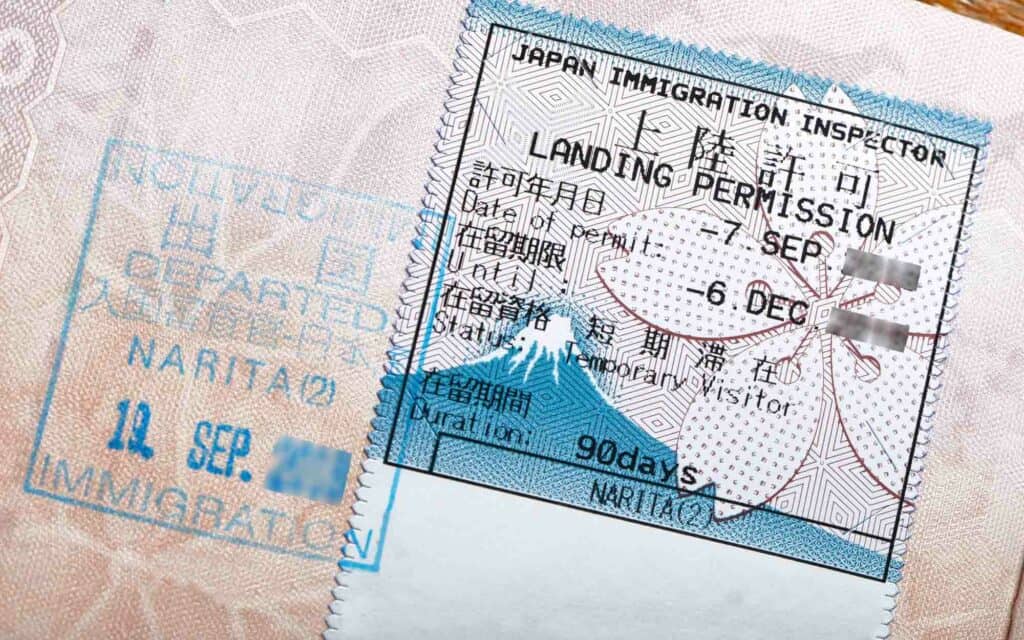
You may use the Visit Japan Web to submit all required information online. It’s not mandatory. Instead of paper forms, you will show QR codes.
After landing, you will sequentially go through immigration and customs.
If you got the eVisa, show your visa issuance notice on a smartphone. Otherwise, just your passport. Get a stamp and enjoy Japan.
Frequently Asked Questions (FAQs)
Is a covid vaccination certificate required to travel to japan.
COVID vaccination certificates and tests are not required since April 29, 2023.
Can I apply for a Japan visa online?
Yes but only if you’re a national or resident of the 11 eligible countries listed above.
How much does a Japan visa cost?
Japan visa costs 3000 YEN or equivalent in another currency.
How long does visa processing take?
Japan visa processing normally takes 5 working days but it could take more. It’s a good idea to apply for a visa at least a month before you travel.
Can I get a multiple-entry visa?
Japan eVisas are single-entry only. Embassies may issue multiple-entry visas depending on your circumstances.
WRITTEN BY THIRUMAL MOTATI

Thirumal Motati is an expert in tourist visa matters. He has been traveling the world on tourist visas for more than a decade. With his expertise, he has obtained several tourist visas, including the most strenuous ones such as the US, UK, Canada, and Schengen, some of which were granted multiple times. He has also set foot inside US consulates on numerous occasions. Mr. Motati has uncovered the secrets to successful visa applications. His guidance has enabled countless individuals to obtain their visas and fulfill their travel dreams. His statements have been mentioned in publications like Yahoo, BBC, The Hindu, and Travel Zoo.
PLAN YOUR TRAVEL WITH VISA TRAVELER
I highly recommend using these websites to plan your trip. I use these websites myself to apply for my visas, book my flights and hotels and purchase my travel insurance.
01. Apply for your visa
Get a verifiable flight itinerary for your visa application from DummyTicket247 . DummyTicket247 is a flight search engine to search and book flight itineraries for visas instantly. These flight itineraries are guaranteed to be valid for 2 weeks and work for all visa applications.
02. Book your fight
Find the cheapest flight tickets using Skyscanner . Skyscanner includes all budget airlines and you are guaranteed to find the cheapest flight to your destination.
03. Book your hotel
Book your hotel from Booking.com . Booking.com has pretty much every hotel, hostel and guesthouse from every destination.
04. Get your onward ticket
If traveling on a one-way ticket, use BestOnwardTicket to get proof of onward ticket for just $12, valid for 48 hours.
05. Purchase your insurance
Purchase travel medical insurance for your trip from HeyMondo . HeyMondo offers a 5% discount to Visa Traveler readers (use the link above), and covers all medical and travel emergencies during your trip.
Need more? Check out my travel resources page for the best websites to plan your trip.
LEGAL DISCLAIMER We are not affiliated with immigration, embassies or governments of any country. The content in this article is for educational and general informational purposes only, and shall not be understood or construed as, visa, immigration or legal advice. Your use of information provided in this article is solely at your own risk and you expressly agree not to rely upon any information contained in this article as a substitute for professional visa or immigration advice. Under no circumstance shall be held liable or responsible for any errors or omissions in this article or for any damage you may suffer in respect to any actions taken or not taken based on any or all of the information in this article. Please refer to our full disclaimer for further information.
AFFILIATE DISCLOSURE This post may contain affiliate links, which means we may receive a commission, at no extra cost to you, if you make a purchase through a link. Please refer to our full disclosure for further information.
MORE VISA GUIDES
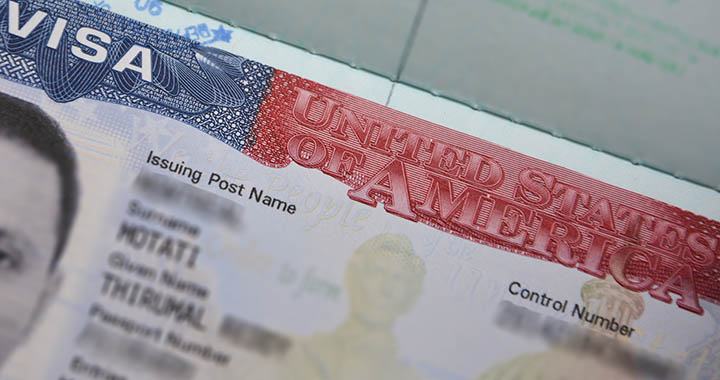
UNITED STATES

UNITED KINGDOM

VIEW ALL VISA GUIDES
- Cookie Policy
- Copyright Notice
- Privacy Policy
- Terms of Use
- Flight Itinerary
- Hotel Reservation
- Travel Insurance
- Onward Ticket
- Testimonials
Search this site
Inside Kyoto
A Kyoto Travel Guide
A Guide to the Visit Japan Web app and Japan Entry Procedures
While it’s recommended to use the Visit Japan web app, it’s not mandatory. In fact it may be quicker to use the standard paper immigration forms on arrival in Japan.

There are now no Covid protocols for Japan. The Japanese government still recommends that visitors to Japan use the Visit Japan Web app, which replaces the paper arrival card and customs declaration, but you DO NOT HAVE TO USE THE VISIT JAPAN WEB APP.
On our last entry to Japan in October 2023, those not using the app actually moved faster through immigration and customs. So, it’s really up to you: use the app or just go old school and fill out a paper arrival card and customs declaration (and if you don’t get them on the plane, you can pick them up at immigration and customs).
Visit Japan Web

Time required to fill out and instruction manuals
When you first download the app and look at the instruction manual, you may get the impression that it’s going to take a long time to complete Visit Japan Web. In practice, it takes about 15 minutes and is pretty intuitive. I suggest using the simplified manual and quarantine section manuals linked below.
Three parts to Visit Japan Web
Note, Visit Japan Web actually consists of three parts: 1) immigration information (ie, disembarkation card information), 2) customs information (ie, customs declaration), and 3) tax-exemption section. When you successfully complete these sections, you will receive three QR codes. The first two you will show at the airport upon arrival. The third you will show at shops that offer tax-free shopping to tourists.
Important tip
You will need a charged smartphone with internet access for Visit Japan Web to work at the airport when you arrive. Japanese airports have free wifi, so connectivity is not an issue, but be sure to charge your phone before flying. Just in case something goes wrong with your phone or you cannot get online at the airport, it’s a good idea to do two things to print out your immigration and customs QR codes to show at the airport.
Important Visit Japan Web Links
- Here’s the Visit Japan Web download site .
- Here’s a detailed manual for using Visit Japan Web.
- Here’s a simplified Visit Japan Web Manual (scroll down for instructions).
Kyoto Vacation Checklist
- For all the essentials in a brief overview, see my First Time In Kyoto guide
- Check Kyoto accommodation availability on Booking.com and Agoda.com - often you can book with no upfront payment and free cancellation
- You can buy shinkansen (bullet train) tickets online from Klook - popular routes include Tokyo to Kyoto , Kyoto to Osaka and Kyoto to Tokyo
- Need tips on where to stay? See my one page guide Where To Stay In Kyoto
- See my comprehensive Packing List For Japan
- You can buy an eSim to activate in Japan or buy a data-only SIM card online for collection when you arrive at Tokyo's Narita or Haneda Airports or Kansai International Airport . You can also rent an unlimited data pocket wifi router
- Compare Japan flight prices and timings to find the best deals
- If you're making frequent train journeys during your visit, you might save money with Japan Rail Pass – see if it's worth it for you
- A prepaid Welcome Suica card makes travelling around Kyoto easy – here's how
- World Nomads offers simple and flexible travel insurance. Buy at home or while traveling and claim online from anywhere in the world
- Do you want help planning your trip? Chris Rowthorn and his team of Japan experts at Japan Travel Consulting can help
Kyoto District Map

- Central Kyoto
- Northwest Kyoto
- Northern Higashiyama
- Southern Higashiyama
- Downtown Kyoto
- Kyoto Station Area
- South East Kyoto
Disclosure: InsideKyoto.com is a participant in the Amazon Services LLC Associates Program, an affiliate advertising program designed to provide a means for sites to earn advertising fees by advertising and linking to amazon.com and amazon.co.uk. World Nomads provides travel insurance for travellers in over 100 countries. As an affiliate, we receive a fee when you get a quote from World Nomads using this link. We do not represent World Nomads. This is information only and not a recommendation to buy travel insurance.
We’re sorry, this site is currently experiencing technical difficulties. Please try again in a few moments. Exception: request blocked
Japanese Visa Requirements
- Published on : 24/12/2012
- by : Japan Experience
- Add to favorites
Find the necessary requirements and procedures for Japanese tourist visas, spouse visas and work visas.
Tourist Visa Requirements For Japan
- Tourist Visas
- Spouse Visas
- General Visa Information
- Living in Japan
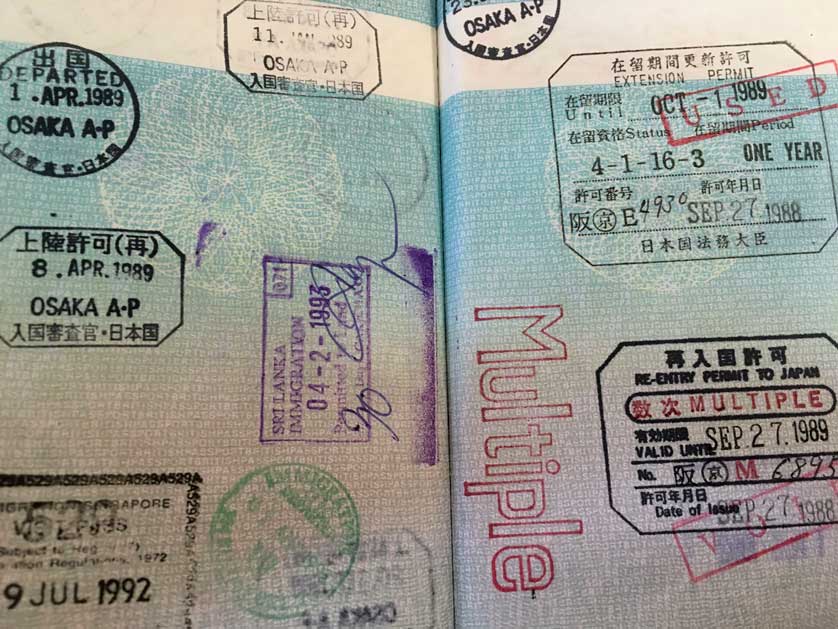
Japanese Tourist Visa Requirements ビザ
Visa-Exempt Countries
Currently visitors from 68 countries and regions around the world are exempt from requiring a visa to enter Japan. This includes most European countries, Australia, New Zealand and North America. See a full list of countries exempt from a Japanese visa requirement .
Note that "visa-free" does not mean "stamp-free." It simply means that you don't have to apply for permission at a Japanese embassy before you come here. When a visitor from a visa-exempt country lands in Japan, permission of stay is granted for 90 days, in most cases, for that entry to the country, but only 15 or 30 days for certain nationalities. A stamp is made in the visitor's passport showing port and date of entry and permitted period of stay (see photo above).
Visa-Required Countries
Nationals from other countries have to obtain a visa in advance to enter Japan. These countries include Russia, China, India, Brazil, the Philippines and some other Asian countries, and most Middle Eastern and African countries. Passport photo(s) and a return ticket are usually necessary. Document processing is usually free of charge, although there is a charge for the visa itself. Fees vary according to whether the visa is single entry, multiple entry or transit. Visitors should also ensure that their passport is valid for at least 90 days following their departure date from Japan.
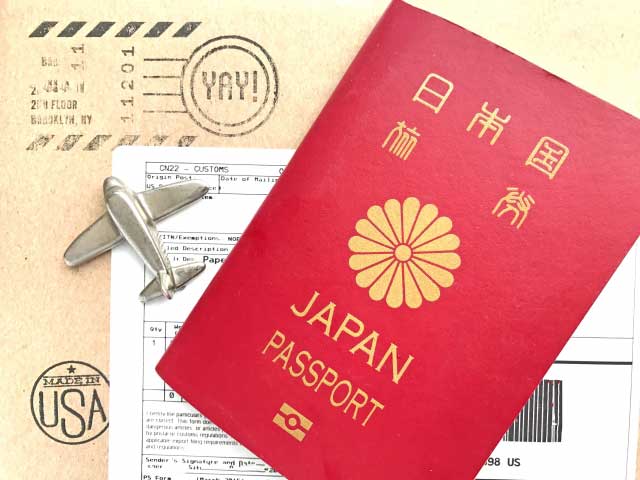
For Russia, NIS countries, China and the Philippines
For nationals of Russia and NIS countries (Armenia, Azerbaijan, Belarus, Georgia, Kazakhstan, Kyrgyzstan, Moldova, Tajikistan, Turkmenistan, Ukraine and Uzbekistan), China and the Philippines, more complicated requirements are in force and visa applicants should see the relevant pages on the Japanese Ministry of Foreign Affairs website where pdf application forms can be downloaded and printed out.
In general, for nationals of Russia, NIS countries and the Philippines an "inviting person" or guarantor resident in Japan (not necessarily a Japanese national) needs to prepare the extra documents and send them to the applicant in his or her own country, who then makes the visa application at the Japanese embassy or consulate in that country. These documents include a "Purpose of invitation" form, a travel schedule and a letter of guarantee. The guarantor must take on liability for the expenses for the applicant's stay in Japan, return travel expenses, and compliance with Japanese laws and regulations.
Philippine nationals are also required to submit a copy of their birth certificate, marriage contract (if the applicant is married), bank certificate and airline ticket reservation form. For further details see the Japanese embassy in the Philippines website .
Individual Chinese applicants for Japanese tourist visas also need to show evidence of annual income above a certain amount, in addition to the above documentation.
Japan tourist visas for Chinese nationals on group tours are limited to 15 days and procedures are carried out by Chinese travel agencies with a Japanese travel agent acting as guarantor.
Applicants for visas in Japan can also find more information and application forms from the Japanese embassy or consulate in their own countries.
Working Visa Requirements
In general, to engage in work at a school, university or Japanese company, applicants will need to fill out an application form from the Japanese embassy or consulate in their own country.
Visas which allow paid work usually require a Japanese company, school, university or individual to act as sponsor.
The following requirements are necessary for obtaining a working visa for Japan: a valid passport, a recent photograph, a letter from your future employer (or sponsor) stating your position and expected salary, a Certificate of Eligibility, a curriculum vitae, or resume and copies of any necessary graduation certificates.
The Certificate of Eligibility (有資格証明書, yuushikaku shomeisho) is issued by the Japanese Ministry of Justice and verifies that you meet all the requirements for a foreign national coming to Japan. You may apply for a Certificate of Eligibility through your local Japanese embassy, but it is more usual for the sponsor in Japan to apply on the foreign person's behalf, i.e., by proxy, through the local immigration office . Being able to show the immigration officer your Certificate of Eligibility when you land in Japan makes entry easier.
Working visas are normally granted for periods of 1 year or 3 years, except for entertainers where the periods are 3 months, six months and one year and are usually extendable.
Work visas are available in the following categories: Artist, Engineer, Entertainer, Highly skilled foreign professional, Instructor, Intra-company transferee, Investor/business manager, Journalist, Legal/accounting services, Medical services, Professor, Religious activities, Researcher, Skilled labor, Specialist in Humanities/International Services.
Like all other categories of applicant, visiting musicians and accompanying technical staff coming to Japan to perform concerts for a limited period also need a Certificate of Eligibility, unless they are exceptionally well known.
Foreign Embassies & Consulates in Japan
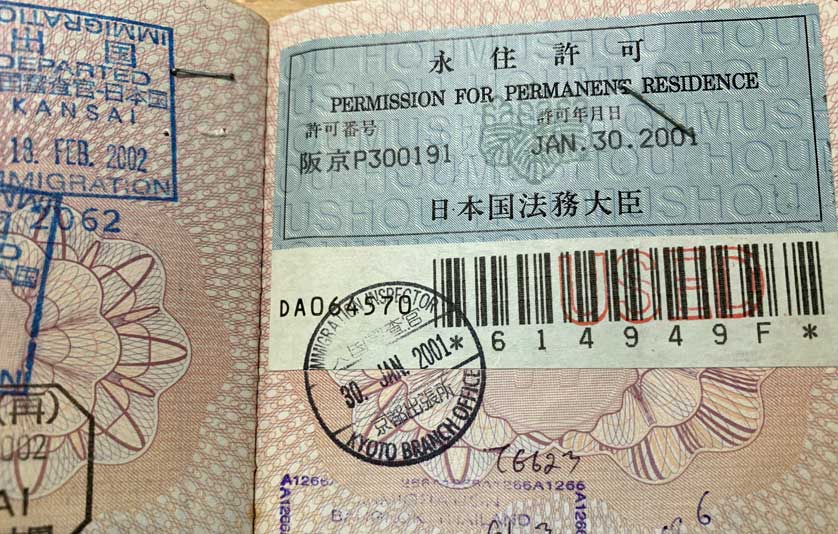
Spouse Visa Requirements
If you marry a Japanese national and wish to apply for a Japanese spouse visa, the following documents must be presented at an immigration office or Japanese embassy or consulate: a valid passport, a spouse visa application form completed and signed, a recent photograph (taken within the past 6 months), an official copy of the Japanese spouse's family register (koseki tohon) available from a ward office and showing your registered marriage, a letter of guarantee from the Japanese spouse, the Japanese spouse's passport or copy, and an official copy of the spouse's certificate of residence (jyuminhyo) available from a local ward office (kuyakusho), plus evidence of financial support (bank statement etc).
Spouse visas are valid for 3 years and must be renewed at your local immigration office or Japanese embassy or consulate overseas.
See our Japan residents section for further information on living and working in Japan .
Books on Japan
Latest Articles
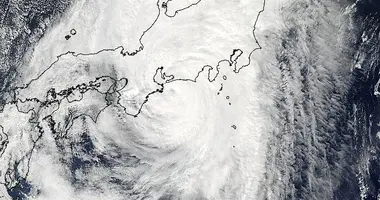
Typhoon season in Japan
Different names are used across the world when talking about tropical cyclones. In the North Atlantic region, we call them hurricanes. In Asia, the term used is typhoon.

Residence Card Zairyu Card: Your Essential Guide to Living in Japan
The Residence Card, also known as Zairyu Card (在留カード), is a crucial document for non-Japanese residents living in Japan.
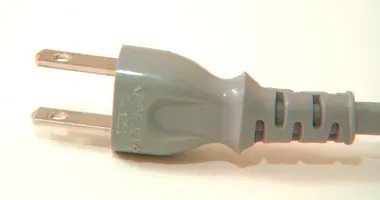
Electrical outlets in Japan: everything you need to know for your trip
When you're planning your trip to Japan, you often think about booking your plane tickets and accommodation, and drawing up your itinerary...
All the themes of the city

Travelling in Japan: a comprehensive guide

Japanese Food and Drink

Japanese Movies

Japanese Language

Japanese History

Understanding Japan
Please select your country on the list below:
- Switzerland
- United Kingdom
- Other countries
- Application
- Requirements
Japan Visa Application Form
Evisa registration, can you apply for a japan e-visa.
The Japanese government has introduced an electronic Japan visa application form to allow select nationalities to apply for an eVisa for Japan online.
Canada, the United States, and Taiwan citizens can now complete the simple online application form . Supporting documents are uploaded in digital format, removing the need for a lengthy in-person embassy application process.
Other nationalities are expected to be added to the eVisa eligibility list in the near future. However, the majority of foreign citizens are still required to submit a Japan visa application in person at an embassy or consulate.
On this page, travelers to Japan can discover the information needed to successfully complete a Japan visa form , whether they are eligible to apply online or need to submit an application in person.
Information Required to Complete a Japan Visa Form
Whether applying online or in person, foreign visitors must provide a range of information on a Japan visa form.
This may include, but may not be limited to:
- Surname and given names as shown in passport
- Date and place of birth
- Sex and marital status
- Citizenship and former or other citizenships
- Passport details including passport type, passport number, and issuing and expiration date.
- Purpose of visit to Japan
- Intended stay in Japan
- Date of arrival in Japan
- Port of entry and transport carrier
- Names and addresses of hotels or persons with whom the applicant intends to stay

Foreign travelers who complete the Japan visa application form are also required to answer a series of security questions.
Security Questions for the Japan eVisa Registration:
The Japanese visa application form may also ask the traveler to answer some security questions before the request can be processed. These may include:
- Has the applicant been convicted of a crime or offence in any country
- Has the applicant been sentenced to imprisonment for 1 year or more in any country
- Has the applicant been deported or removed from Japan or any country for overstaying their visa or violating the law?
- Has the applicant been convicted and sentenced for a drug offence in any country in violation of law concerning narcotics, marijuana, opium, stimulants or psychotropic substances?
- Has the applicant engaged in prostitution or in the intermediation or solicitation of a prostitute for other persons, or in the provision of a place for prostitution, or any other activity directly connected to prostitution?
- Committed trafficking in persons or incited or aided another to commit such an offence?
If an applicant answers yes to these questions they are required to provide relevant details of their situation.
As it is with other legal applications, travelers must answer truthfully to each section of the Japan visa application form . Information must be precise and accurate. Applicants are advised to revise their application details and documents before submitting their Japan visa form.
How to Get a Visa for Japan
If you are a foreign visitor and wish to visit Japan for a short period of time and will not participate in remunerated or paid activities you can apply for an eVisa or a temporary visitor visa from an embassy, depending on your nationality.
To get a Japan visa for a short-term stay, the majority of foreign citizens need to apply at a Japanese Embassy or Consulate in person. However, citizens of Canada, the United States, and Taiwan can now apply for an eVisa online .
An eVisa for Japan allows the holder to visit Japan for tourism, business activities, various exchanges, or to visit relatives .
How to complete a Japan Visa Application Online
To get an eVisa for Japan, eligible foreign citizens must complete an online form with their personal, passport, and travel information.
They must also meet the Japan eVisa requirements and upload a few supporting documents before paying a service fee and submitting their Japan visa form. It is then necessary to pay the eVisa fee in person at the nearest Japanese overseas office.
Once the Japan visa application has been approved and the fee paid, applicants are notified of the eVisa approval via email. They can then access the Visa Issuance Notice digital document.
This must be presented at the airport , alongside the same passport used to complete the online form, in order to board a flight to Japan.
The process for applying for a Japan visa from an embassy is similar, but the entire process must be completed in person. Applicants are required to both submit their Japan visa form in person and to collect the approved document once it is approved.
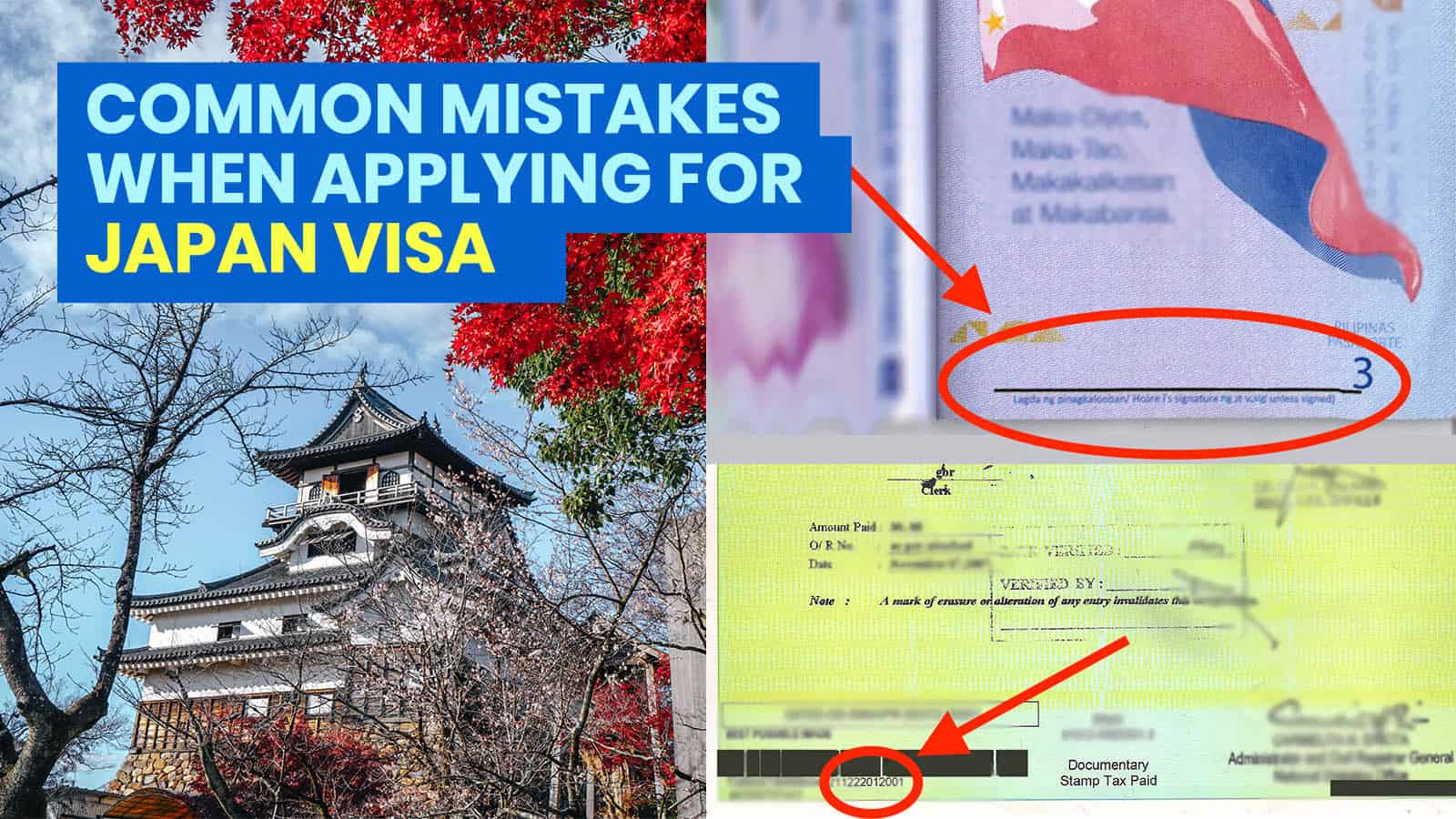
Avoid These 12 COMMON MISTAKES when Applying for a JAPAN VISA!

The Japanese visa is one of the easiest visas to secure for Filipinos. Ask a random Pinoy international traveler what their very first visa is and there’s a big chance it’s for Japan. Over the past decade, the Japanese Embassy has been very considerate, allowing more Filipinos to visit and explore their country.

The Japanese visa application is very straightforward. You complete their list of requirements, submit them through an accredited agency, and wait for the result. The agencies assess the documents one by one to make sure that everything is in order. But sometimes, there are things that applicants fail to notice, throwing a wrench into an otherwise smooth process.
Here are some of the common mistakes that Japanese visa applicants make.
1. Forgetting to sign the passport
Philippine passports must be signed to be valid. Older passports have your digital signature on the information page (Page 2). But the most recent version, the one with a 10-year validity, no longer has a digital signature.
You’ll be surprised by how many applicants don’t notice that there is a SIGNATURE LINE on Page 3 instead, just below the Philippine flag. And yes, it has to be signed.
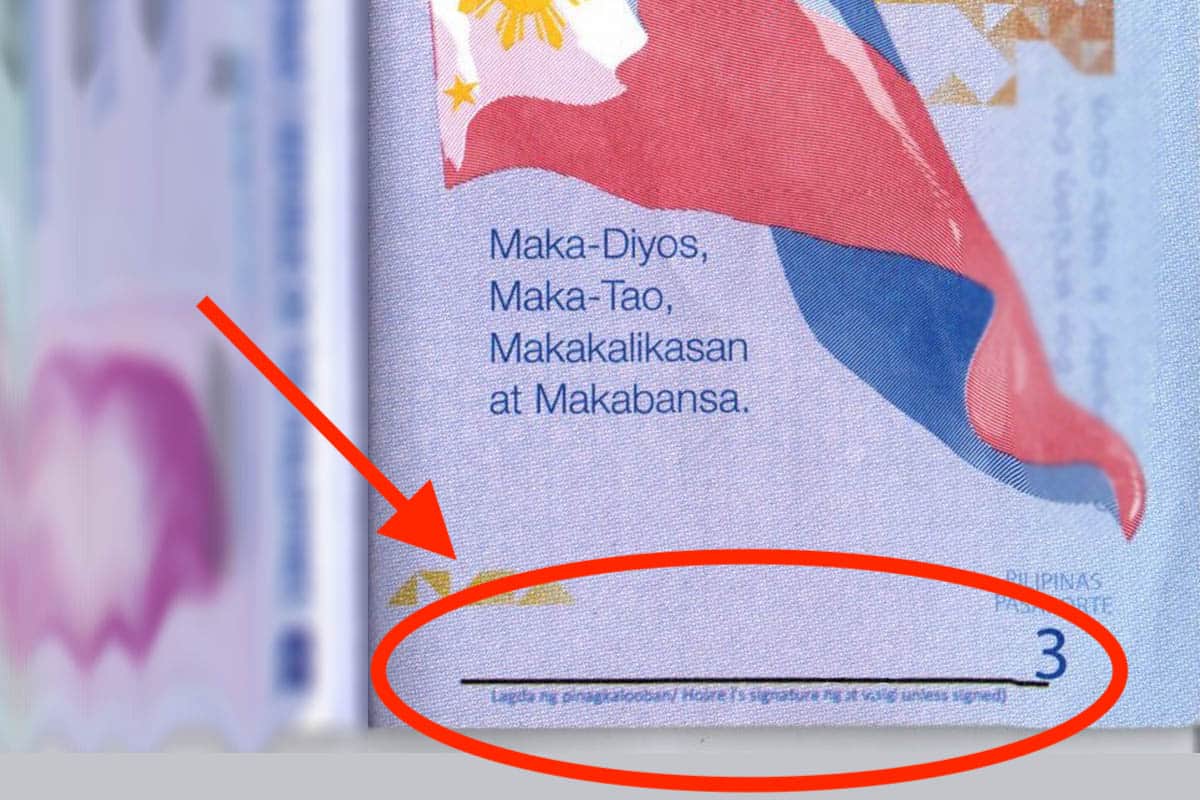
You might be thinking it isn’t really that big of a deal because you can simply sign it. But it gets more complicated when you’re applying for someone who isn’t with you at the time. It happened to me once, when I applied in Manila for a family member who was in the province. I had to return and apply another time.
It’s also important to note that the passport must have at least 2 blank pages and at least 6 months validity.
2. Not using the right paper size (A4)
The Japanese visa application standard paper size is A4. All documents that you have control of the printing must be in A4 size. These documents include:
- Application form
- Daily schedule in Japan (itinerary)
- List of Visa Applicants (for group application)
- Invitation letter
- Guarantee letter
- Explanation letters
The agency may decline these documents if not in the right size.
3. Submitting birth certificates older than 1 year
The birth certificate must be issued by the PSA Main Office or Serbilis Outlet Center within the past one year. They don’t accept it when it’s older than that. They can see the date it was issued within the code at the bottom of the document.
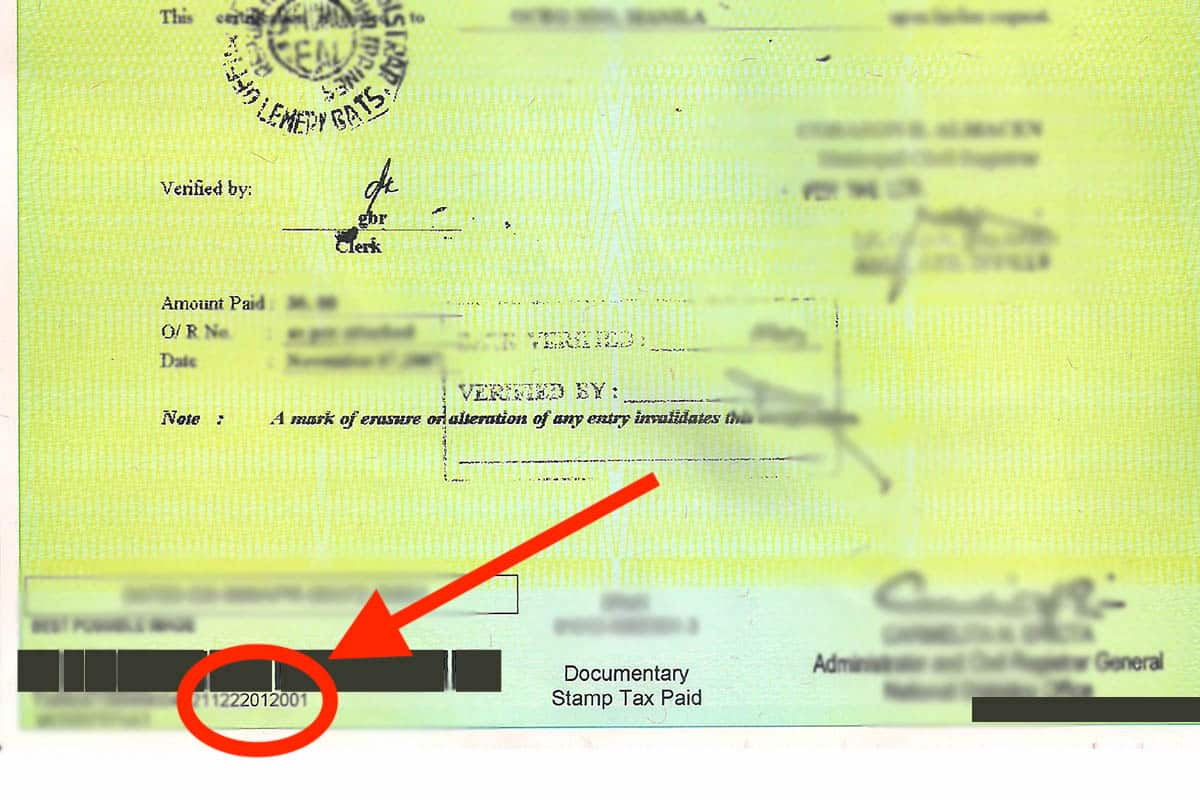
This is pretty common. Every time I apply at any agency, there’s always an applicant in the room who was asked to come back with a more recent copy of the birth certificate.
I don’t know why it has to be new, to be honest. But that’s the rule.
4. Failure to provide additional documents for late registration or no record
Another complication that many applicants overlook is the additional requirements when the birth certificate is marked “Late Registration”.
If you’re late-registered, submit a Baptismal Certificate and School Record (Form 137) from high school or elementary and School Yearbook (if applicable).
Moreover, if there is no record in PSA, submit a “Certificate of No Record” from PSA together with a birth certificate from the Local Civil registrar.
5. Applying too late
The Japanese Embassy processes applications fast. I have experienced getting my visa as early as two days after submission. That said, it doesn’t mean that you have to cut it too close to your travel date because in some unlucky cases, it can take much longer, sometimes weeks!
In addition, some agencies refuse to accept applications with travel dates that are shorter than a week away. For example, Reli Tours at SM Megamall has a 7-working-days policy. If the flight is scheduled sooner than 7 working days at the time of submission, they will NOT accept your application. It happened to a relative whom I accompanied at the agency. They turned us away and asked that we apply at another agency instead.
I’m not sure if other travel agencies have the same policy. Call them first if your trip is urgent.
6. Applying as a tourist but staying with a relative
We get a lot of inquiries about this. Tourist visa processing is way cheaper and way less complicated than a Visit visa, so it’s always tempting to go the former route. However, don’t apply for a tourist visa just because it’s convenient!
If you’re staying with a friend or relative in Japan, apply for a Visit Visa. It doesn’t make any sense to aim for a tourist visa when your documents clearly show you’re visiting and staying with someone there.
If you’re applying for a Tourist Visa, the logical Japanese address to write on the application form is that of a hotel, hostel, or another commercial accommodation.

7. Ignoring the “List of Visa Applicants” form when applying as a group
If you’re applying with a group or family, you need to accomplish and submit a form called “List of Visa Applicants.”
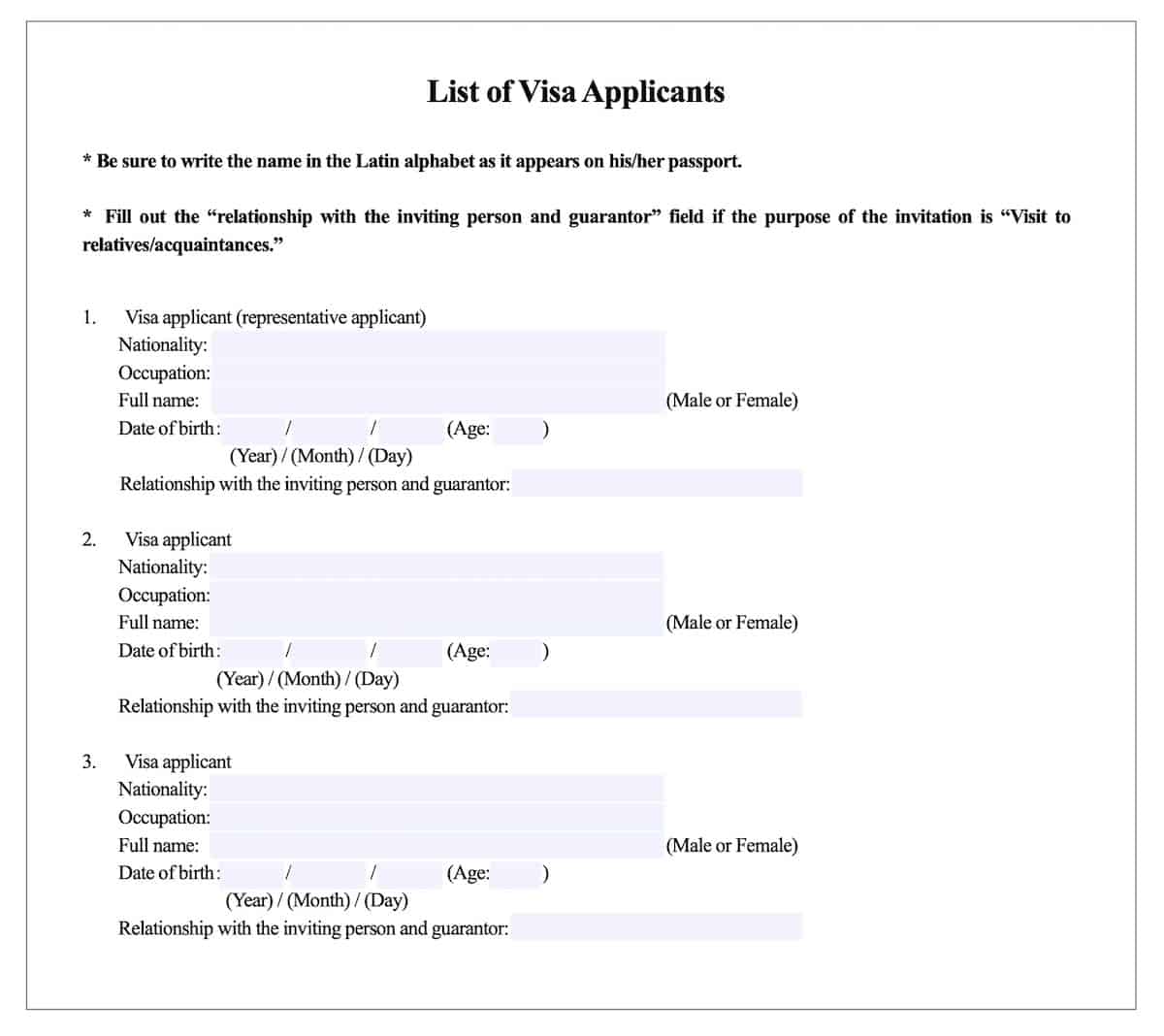
Bear in mind the following:
- You must have a REPRESENTATIVE APPLICANT, who will be the key person in your application. For example, if you’re applying as a family, one of the parents can be the representative. If one of the applicants/travelers will be sponsoring the rest of the group, that person can also be the representative.
- In the “relationship with the inviting person and guarantor” field, write N/A if you’re applying as a tourist. Fill this in only if you’re visiting friends or relatives in Japan.
- Must be printed on an A4-size paper. No other size is accepted.
You can download the form here .
No need to submit this if you’re applying alone.
8. Applying for a multiple entry visa when ineligible
If it’s your first time applying for a Japan visa, it’s best to aim for a single entry visa unless it’s justified or you’re eligible. If any of these apply to you, go for it:
- If you have travelled to Japan as temporary visitor within the last three years AND have sufficient financial capability to support their trip.
- If you have travelled to Japan as temporary visitor within the last three years AND have travelled as temporary visitor to G7 countries (excluding Japan) several times within the last three years. The other G7 countries are: Canada, France, Germany, Italy, the United Kingdom (UK) and the United States (USA).
- If you have high financial capacity (but has not been to Japan in the past 3 years). The keywords here are HIGH FINANCIAL CAPACITY.
- If you are an immediate family member (Spouse/Child) of a person who has high financial capacity.
If you’re none of the above, apply for a single entry visa in the meantime. Otherwise, you might be risking your application.
Anyway, sometimes they grant multiple entry visas to applicants who didn’t even request for it. (I know this because it happened to me.)
9. Not having enough funds to support your trip
The Embassy doesn’t explicitly say how much money you should have in the bank. The amount isn’t the only factor. It’s probably on a case-by-case basis.
- I have applied for a 15-day stay with only P100,000+ in the bank and my application got approved.
- A friend of mine applied for a 5-day stay with only P50,000 and got approved. She has a full-time job.
- Another friend applied for a 5-day stay with over P200,000 and got denied. She doesn’t have a regular job.
The rule of thumb is: your funds should be proportional to the length of stay. For example, if you have only P50,000, don’t apply for a 30-day stay because that would obviously raise a lot of questions regarding whether or not you can afford the trip.
10. Inconsistent application form and documents
Make sure that the information you write on the application form matches the supporting documents you submit. For example, if on the form you state you plan to stay in Japan for 5 days, don’t submit a 15-day itinerary. If you write on the form that you work for a certain company, your ITR should match.
If something doesn’t match, prepare an Explanation Letter. This happened to me before. At the time, I had just recently moved to another company so my ITR was from my previous employer. I had to write on the spot an explanation why employer on the form is not the same on my ITR.
11. Forgetting the seal or signature on the Guarantee/Invitation Letter
What I like about Japan visa application is that they have standard forms for everything, including Invitation and Guarantee letters. You don’t need to guess the information you need to include because they are indicated on the form.
The problem with this is that there are certain items that are easy to overlook because of their placement. One of them is the SEAL .
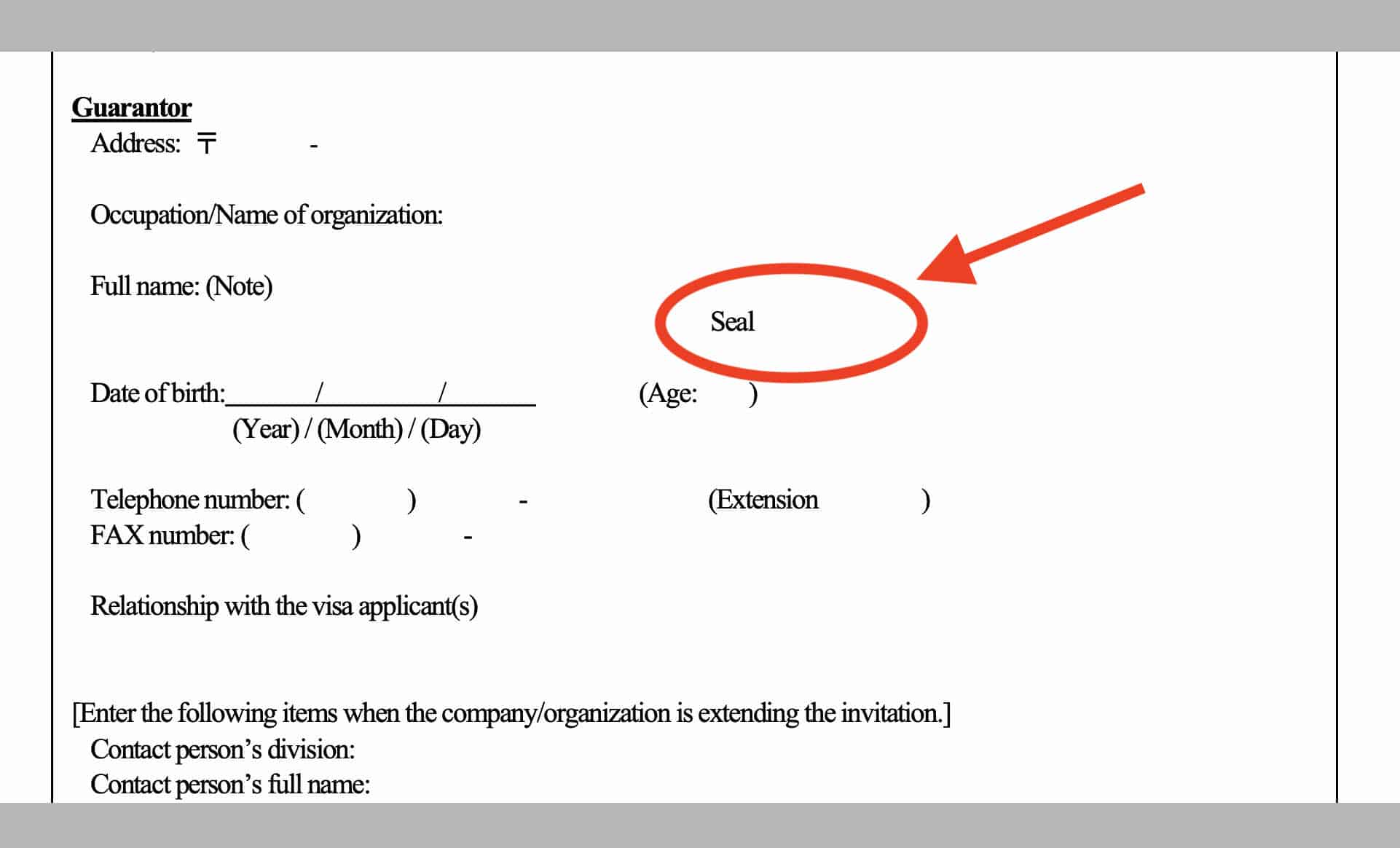
Japan residents have a seal that they use on official documents. If your inviter or guarantor is a Japanese national or resident, have these documents stamped by them. If your inviter or guarantor is a foreign national who does not have a seal, they must put their signature in the same area.
12. Leaving non-applicable fields blank
If the question doesn’t apply to you, write N/A.
This is quite confusing because Japan and Korea have different policies, and most designated agencies process both Japan and Korean visas.
But here’s the generally accepted practice: For Japan Visa form, write N/A.
Related Japan Visa Posts
- Japan Visa Requirements for TOURISTS
- Japan Visa Requirements for VISITING RELATIVES OR FRIENDS
- How to Get a Multiple Entry Japan Visa
- How to Fill Out Japan Application Form
- Common Reasons why Visa Applications are DENIED!
- FIRST TIME ABROAD: Immigration Tips
- How to Avoid Getting OFFLOADED: Immigration Requirements & Tips
2020 • 2 • 25
More Tips on YouTube ⬇️⬇️⬇️
Is this post helpful to you?

Related Posts:
- HOW TO RENEW JAPAN VISA & Other Frequently Asked Questions
- MULTIPLE ENTRY JAPAN VISA: Requirements & How to Apply
- JAPAN VISA APPLICATION FORM: Sample + How to Fill it Out
- JAPAN VISA FOR VISITING FRIENDS OR RELATIVES: Requirements & Steps
- Sample INVITATION LETTER for JAPAN VISA Application (Reason for Invitation)
- SAMPLE ITINERARY for JAPAN VISA Application (Schedule of Stay)
- IMPORTANT JAPAN VISA UPDATE: Additional NCOV/COVID-19 Form to be Submitted
- JAPAN Suspends Visas Issued in the Philippines Prior to March 27

- Recent Posts
- 2024 Cebu Pacific Promos & PISO SALE with Number of Seats Available - 7 September 2024
- U.S. VISA APPLICATION Requirements & Interview Questions in the Philippines - 4 August 2024
- WHERE TO SHOP IN BANGKOK • Top 8 Shopping Centers and Malls - 29 July 2024
So if I am applying with my Wife for Tourist Visa for Japan then Me and My wife Needs to fill two separate application form and My Wife need to fill this “List Of Visa Applicants” where my name would be in reprensentative section.
Should my wife need to mention in relationship with Gurantor section as a “Husband” or it would be “N/A” only in Tourist Visa app?
She needs to fill out her own application form too. The list of visa applicants is simply used by the Embassy as reference to check which applicants are traveling together. Re Guarantor, See FAQ 1.
Btw, I’m assuming you’re applying from the Philippines.
Hi! Me and my girlfriend are planning to visit Osaka this coming March 2023, we already secured a ticket for 7 days. I’ve been to Japan in 2019 and would like to take my girlfriend there to celebrate our anniversary.
My mother would like to sponsor our trip and be our guarantor, can we just write on the application form of guarantor the relationship of my girlfriend and my mother as “son’s girlfriend”?
Hi I was born in September 1986 and my birth certificate was registered in November the same year is that already considered late registration? Do I really need to submit Form 137?
Hello Sir Yosh, can we still need a list of applicant form? me and my sister will apply as visit relative.
If you’re traveling with a group, yep!
Hello, I would like to ask if is it possible to enter japan when your birth certificate is late registered? My mother’s birth certificate was registered late, she has a baptismal certificate but do not have form 137 nor tor because she was not able to enter school.
Hello mr yosh. We will be traveling as a couple. Should i still fill up the “list of applicants” form? Thank you
Yep, if you’re traveling together.
is it true na malaki ang chances na dedeny ng japan visa ang mga solo travelers na babae na walang travel history?? if so, i am screwed. TT^TT
hello sir, Flight booking is mandatory or i can buy ticket after my visa approval? because may be Visa will refuse then money loss? I’m planning to apply for tourist visa.
Flight booking is NOT a requirement. You can buy ticket after.
Helpful post! I was wondering, you mentioned you had to write an explanation letter explaining why the employer on your ITR and your Visa application form were different. I’m in the same situation, I just moved to a new company so the one indicated on my ITR is different. Did you have to provide a COE from your new employer?
Hi! Yes. I always submit a COE for Japan kahit di required.
Featured On

We heard you!
Your comment is now queued for moderation! We’ll try to get back to you soonest. While waiting, follow us on these channels.
Subscribe on Youtube! Follow us on Instagram!

We use cookies on this site to enhance your user experience. If you continue to browse you accept the use of cookies on our site. See our Cookie Policy for more information.
- Media & Industry
- Meetings & Events
- Select Language 简体中文 繁體中文(香港) 繁體中文(臺灣) India (English) Bahasa Indonesia 한국어 ภาษาไทย Tiếng Việt Singapore (English) Philippines (English) Malaysia (English) Australia/New Zealand (English) Français Deutsch Italiano Español United Kingdom (English) Nordic countries(English) Canada (English) Canada (Français) United States (English) Mexico (español) Português العربية Japan(日本語) Global (English)
- India (English)
- Bahasa Indonesia
- Singapore (English)
- Philippines (English)
- Malaysia (English)
- Australia/New Zealand (English)
- United Kingdom (English)
- Nordic countries(English)
- Canada (English)
- Canada (Français)
- United States (English)
- Mexico (español)
- Global (English)
- Fujiyoshida
- Shimonoseki
- Ishigaki Island
- Miyako Island
- Kerama Island
- Tokyo Island
- Koka & Shigaraki
- Hida Takayama
- Ginza, Nihonbashi
- Beppu & Yufuin (Onsen)
- Ginzan Onsen
- Nagasaki Islands

- Kumano Kodo
- Shikoku Karst
- Amami Oshima
- Hachimantai
- Omihachiman
- Aizuwakamatsu

- Diving in Japan
- Skiing in Japan
- Seasonal Flowers in Japan
- Sustainable Outdoors
- Off the Beaten Track in Japan
- Scenic Spots
- World Heritage
- Home Stays & Farm Stays

- Japanese Gardens
- Japanese Crafts
- Temple Stays
- Heritage Stays
- Festivals and Events
- Theater in Japan
- Japanese Tea Ceremony
- Cultural Experiences in Japan
- Culture in Japan

- Local Cuisine Eastern Japan
- Local Cuisine Western Japan
- Local Street Food
- Japan's Local Ekiben
- Japanese Whisky
- Vegetarian and Vegan Guide
- Sushi in Japan Guide
- Japanese Sake Breweries

- Art Museums
- Architecture
- Performing Arts
- Art Festivals
- Japanese Anime and Comics
- Japanese Ceramics
- Local Crafts

- Scenic Night Views
- Natural Wonders
- Theme Parks
- Samurai & Ninja
- Iconic Architecture

- Wellness Travel in Japan
- Japanese Ryokan Guide
- A Guide to Stargazing in Japan
- Relaxation in Japan
- Forest Bathing (Shinrin-yoku)

- Experiences in Japan
- Enjoy my Japan
- National Parks
- Japan's Local Treasures
- Japan Heritage
- Snow Like No Other
- Wonder Around Japan

- Visa Information
- Getting to Japan
- Airport Access
- COVID-19: Practical Information for Traveling to Japan
- Anime Tourism
- Countryside Stays
- Accessible Tourism
- Hokkaido Great Outdoors
- Scenic World Heritage in Tohoku
- Shikoku’s Nature and Traditions
- Southern Kyushu by Rail

- Traveling by Rail
- How to Travel by Train and Bus
- JR Rail Passes
- Scenic Railways
- Renting a Car
- Sustainable Travel in Japan
- Travel Brochures
- Useful Apps
- Online Reservation Sites
- Eco-friendly Accommodation
- Luxury Accommodations
- Traveling With a Disability
- Hands-free Travel
- How to Book a Certified Tour Guide
- Volunteer Guides
- Tourist Information Center

- Japanese Manners
- Spring in Japan
- Summer in Japan
- Autumn in Japan
- Winter in Japan
- Cherry Blossom Forecast
- Autumn Leaves Forecast

- Japan Visitor Hotline
- Travel Insurance in Japan
- Japan Safe Travel Information
- Accessibility in Japan
- Vegetarian Guide
- Muslim Travelers
- Safety Tips

My Favorites
${v.desc | trunc(25)}
Planning a Trip to Japan?
Share your travel photos with us by hashtagging your images with #visitjapanjp
- Visa Application
Travel Tips
AC Bonifacio in Japan
VIEW THIS IN FILIPINO

Top things to remember for first time travelers
Before you have an experience of a lifetime in your Japan trip, you just need to take care of the most important thing first, your Japan Tourist Visa! Below is a guide on how you can apply for your Japan Tourist Visa as well as fulfilling requirements for travelers to Japan.
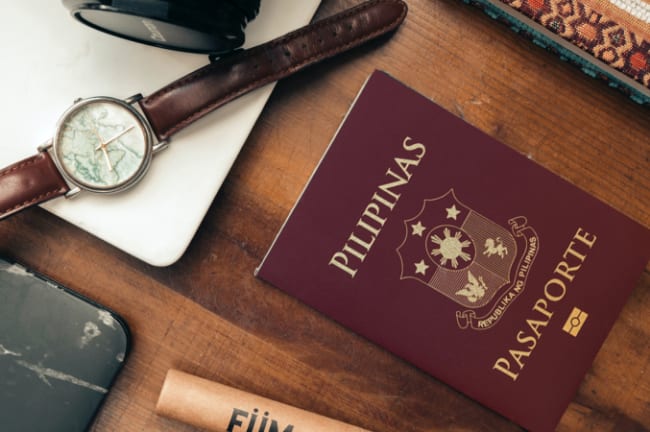
How to Apply for Japan Tourist Visa
Below is a step-by-step guide on how to apply for a Japanese Tourist Visa.
Note: The Japan National Tourism Organization (JNTO) cannot facilitate Visa applications nor can we answer Visa-related inquiries.
For Visa-related inquiries, kindly contact the Japanese Embassy in the Philippines. https://www.ph.emb-japan.go.jp/itpr_en/00_000035.html
- Passport (holder’s signature required)
- Visa Application form (one 4.5cm x 3.5 cm facial photo must be attached)
- Birth Certificate (issued by PSA within one year)
- Marriage Certificate (issued by PSA within one year, for married applicants only)
- Itinerary in Japan
Note: If there is a used Japanese Visa on your passport, birth certificate and marriage certificate are unnecessary.
If applicant will shoulder part/all travel expenses:
- Bank certificate
- Photocopy of Income Tax Return (BIR Form 2316)
If a guarantor will shoulder part/all travel expenses:
- Guarantee letter
- Proof of relationship between applicant and guarantor (e.g. birth certificates)
- Bank Certificate
You can get the application form from The Embassy of Japan in the Philippines website .
Make sure to make extra copies.
You can submit your application form with the required documents through these accredited travel agencies .
The Visa-handling fee for the Japan Tourist Visa varies per travel agency. You must pay the fee after you submit your documents.
The travel agency will contact you if your passport is ready for pickup.
Guides for Entry to Japan
Useful links.
Visit Japan Web
Visit Japan Web is a web service that people entering Japan can use to fast-track Immigration, and Customs procedures in order to enter/return to Japan.
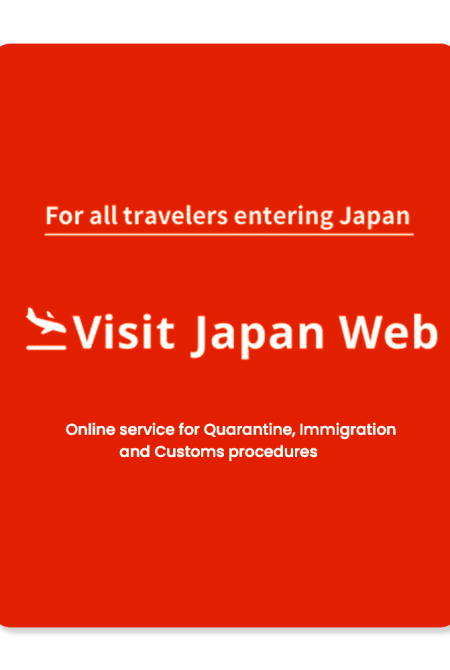
COVID-19 Protocols
Learn everything you need to know about traveling to Japan with COVID-19 protocols.
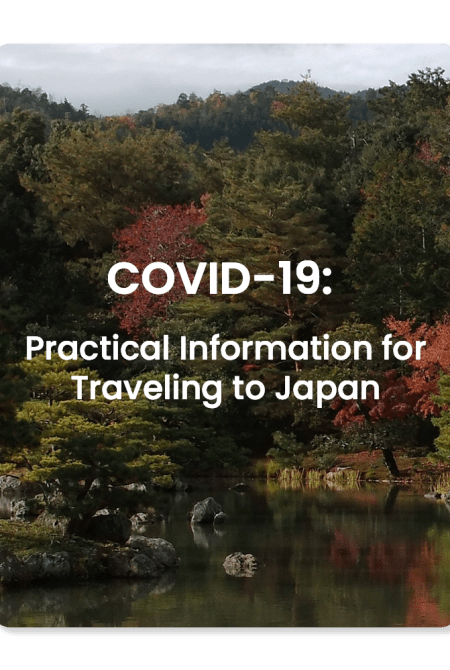
- Irasshaimase
Please Choose Your Language
Browse the JNTO site in one of multiple languages
The Ministry of Foreign Affairs website uses JavaScript. Please turn on "JavaScript" and use it.

Frequently Asked Questions
1. Prior to the Application
Q1: i want to go to japan. do i need a visa.
A1: People of some countries (or from some regions) do not need a visa if their period of stay in Japan is 90 days or less and they are not going to be engaged in income-earning activities. Refer to the List of Countries and Regions that have Visa Exemption Arrangements with Japan .
Q2: I want to invite a foreign national to Japan. What procedures are necessary?
A2: (1) In the case of an invitation for the purpose of a short-term stay (in the case that you are inviting relatives or friends, employees of a company with which you do business, etc. for a period of stay of 90 days or less and will not be paying them an income), please write a Letter of Reason for Invitation and draw up a Schedule of Stay. If you are inviting a person from China / Russia / CIS countries / Georgia, and if you will pay travel expenses instead of the visa applicant (who wishes to come to Japan), a Letter of Guarantee, the certificate of residence of the guarantor, and documents confirming the capacity of the guarantor to pay the expenses should also be prepared in addition to the above documents regardless of the applicant's nationality. (2) In the case of an invitation for the purpose of a long-term stay (spouse, working, studying, etc.), it is recommended that you start by applying to your nearest Regional Immigration Service Bureau to have a Certificate of Eligibility issued. (3) Once you have prepared all of the above documents, send them to the visa applicant. Check here for details.
Q3: What should I do to get a Certificate of Eligibility?
Q4: the certificate of eligibility will not arrive by the time i apply for a visa. can i still apply for a visa with its copy.
A4: From March 17, 2023, it will be possible to receive a Certificate of Eligibility (COE) by email and to apply for landing by presenting the email. When applying for a visa, the application can be accepted by presenting the email or submitting the printed copy. For those who have a paper Certificate of Eligibility, they can also apply for landing and a visa by submitting its printed copy after March 17.
Q5: Is it necessary to go to the Japanese Embassy / Consulate General by myself to apply for a visa?
A5: There are four ways to apply for a visa: (1) the visa applicant him/herself goes directly to the Japanese Embassy / Consulate General, (2) the visa applicant writes a Letter of Proxy and get a proxy to go to the Japanese Embassy / Consulate General in his / her place, (3) the visa applicant uses an accredited travel agent approved by the Japanese Embassy / Consulate General and (4) the visa applicant uses the JAPAN eVISA website and apply for visa online. However, depending on the circumstances in your country or region, there are cases that the documents should only be submitted by the applicant him/herself going to the Japanese Embassy/Consulate General, or through an accredited travel agent. Check with the embassy or consulate general to which you plan to apply before making the application . For information on the countries/region where the JAPAN eVISA website is available, please refer to the online visa application page .
Q6: Can I apply for a visa at the nearest Japanese Embassy / Consulate General while traveling in a foreign country?
A6: You can apply for the visa at the Japanese Embassy / Consulate General in your own country (region) or country (region) of residence (if there is more than one, apply to the Japanese Embassy / Consulate General nearest from where you live). In other words, you cannot apply for a visa at your travel destination; however, if there are unavoidable circumstances, consult with the Japanese Embassy / Consulate General where you would like to apply for the visa before making the application.
Q7: Why was my visa application not accepted?
A7: If any of the following cases apply to you, your application may not be accepted.
- (1) Applications from persons holding Japanese nationality
- (2) The application is made to the Japanese Embassy / Consulate General outside your country (region) of birth or country (region) of residence
- (3) You currently hold a valid visa or re-entry permit
- (4) Your previous visa application to visit Japan for a specific purpose was rejected and you reapply to visit Japan for the same purpose within six months from the rejection
- (5) The visa application is already being processed at a different Japanese Embassy / Consulate General
- (6) There are some errors or omissions in the submitted documents
- (7) The period of validity or the visa attachment space of your passport is insufficient
- (8) The application is made by a person who does not have the qualifications to make a proxy application
- (9) An application for issuance of a Certificate of Eligibility is still pending

2. Application Examination
Q1: how long is the application examination period.
A1: The standard processing period, when it does not have any problem on contents of the application, takes five working days from the next day after the date of the acceptance of application. Meanwhile, it may take longer than usual if a large number of visa applications converge at a short-time period. In addition, please note that it may take more than 5 working days (ranging from a couple of weeks to several months) in such cases where additional confirmation is required (submission of additional documents, an interview with the applicant, inquiries, etc.), or when a visa application is made for a long-term stay without a Certificate of Eligibility. Thus, visa applicants are recommended to apply early for their visa well in advance of the anticipated travel date.
Q2: Why was I asked to provide additional documents?
A2: Sometimes additional information will be required for the examination process, and sometimes you will be asked in the process to submit extra documents in addition to the documents indicated as the necessary documents. Each applicant has different conditions and circumstances, and sometimes we do not become aware of these until the application has been accepted, therefore there are some documents that we do not ask everyone to submit from the beginning. If you do not submit the additional documents, the examination cannot be processed any further, and you will not be able to get the visa issued.
Q3: My departure date is approaching so could you issue the visa as soon as possible?
A3: We cannot make a decision about whether to issue or reject the visa application until the necessary examination has been completed. We process the applications fairly in the order in which we received them. Apply for the visa as soon as possible once your travel plan has been decided.
3. Issuance or Rejection of the Visa Application
Q1: tell me why you rejected my visa application..
A1: The reason for the rejection is that your application did not meet the criteria of visa issuance . We do not give you the specific reason of the rejection because if we do so, the information would eventually become known to the public. Once that happened, there is a danger that some people might misappropriate such information to get around the visa examination process and try to enter Japan for illegal purposes. It would impede the proper visa examination process in the future and have negative effects on Japanese society. The Administrative Procedure Act, Article 3, Paragraph 1, Item 10 excludes "dispositions concerning departure and immigration of foreign nationals" from application of the obligation to show the examination criteria or the reasons for the rejection of the application.
Q2: Why was my visa application rejected even though a Certificate of Eligibility was issued?
A2: The Certificate of Eligibility does not guarantee the issuance of the visa. The certificate means that the Ministry of Justice certifies that the foreign national meets the condition of landing (entering Japan): the activity which the foreign nationals wish to engage in Japan at the time of the landing examination is not fraudulent, and the activity is qualified to acquire status of residence that is stipulated in the Immigration Control Act, etc. Therefore, in the visa examination process, we do not examine the applicability of status of residence, but some other points such as the verification of the applicant's identity and the validity of his/ her passport. If it is found that the application does not meet the criteria of visa issuance in the process of examination, or it is determined that the Certificate of Eligibility was issued based on mistaken or fraudulent information, a visa will not be issued.
Q3: Why can't I reapply immediately after my visa application was rejected?
A3: We do not accept your visa application if your previous application was rejected and you will apply for the same purpose of visit within six months from the rejection. This is because if, for example, we accept the same application the day after it was rejected, the circumstances of the applicant would not change so that the result of examination would be the same. However, we sometimes accept re-applications within six months in cases where your circumstances have changed significantly after the rejection, and travel to Japan is necessary for humanitarian reasons. Consult with the Japanese Embassy or Consulate where you plan to apply for the visa before making the application.
Q4: Can I pay visa issuance fees with a credit card or a check?
A4: In principle, fees must be paid in cash using the local currency. In case that you apply for eVISA through the JAPAN eVISA website, online payment by credit card is available for certain countries and regions. You will not be required to pay visa issuance fees if the visa is not issued.
4. Prior to Entering Japan
Q1: i want to postpone my travel. until when is my visa valid.
A1: The period of validity of a single-entry visa (that becomes invalid as soon as once you enter Japan) is basically three months. Enter Japan within three months of the issuance of the visa. If you wish to postpone your travel for longer than three months, you will be required to make another visa application.
Q2: I have decided not to invite a foreign national to Japan after all. What should I do?
A2: Please report that you have cancelled the invitation, together with the personal identification information of the visa applicant, by email to the Embassy / Consulate General where the visa was issued. In addition, tell the visa applicant to bring his/her passport to the Japanese Embassy / Consulate General to cancel his/her visa. Note that visa fees will not be refunded even if the visa is cancelled before being used.
Q3: I have lost my passport with the visa in it. What should I do?
A3: Contact the Japanese Embassy / Consulate General that issued the visa to inform what happened. Also, it is recommended that you submit a lost property form to the local police station. If you need a new visa, you must make an application again.
Q4: Why was my application to enter Japan rejected even though I had a valid visa?
A4: A visa is no more than one of the requirements for the application to land in Japan and it does not guarantee that you will be able to enter Japan. (There is a warning on the visa application form and your signature on the application form means you have accepted this fact.) Even if you have a valid visa, sometimes you will not be given permission to enter Japan, for example in cases where the person who makes the landing application is different from the person whose name is recorded in the visa, and also in cases where you cannot properly explain to the immigration officer the activities you plan to engage in after entering Japan.
Q1: How will the personal information submitted at the time of visa application be handled?
A1: The personal information of the visa applicant, inviting person and guarantor will be managed appropriately in the Japanese Embassy / Consulate General based on the Act on the Protection of Personal Information. Also, local travel agencies that wish to handle visa applications have to get the approval by Japanese embassies /consulates, and the condition of such approval is that they have agreed to manage personal information appropriately based on the aforementioned act, under the same criteria as the outsourcing organization.
Q2: What is the legal basis for the issuance or non-issuance of my visa?
A2: Under the international customary law, the decision as to whether or not to issue a visa to a foreign national is determined to be a sovereign act of each country. Japanese consuls carry out the administration related to visas based on the Act for Establishment of the Ministry of Foreign Affairs (Article 4 Item 13, Article 7 Item 1, and Article 10 Item 2 and Item 3).
Q3: Isn't the refusal of a visa for a spouse of Japanese an infringement of human rights?
A3: Entering Japan is not a right of a person of foreign nationality, so this is not an infringement of human rights. On the other hand, there are sometimes cases of human trafficking in which people from developing countries in an economically and socially vulnerable position are brought to developed countries for fake marriages, illegal work, etc. With this issue in mind, Japan is carrying out careful visa examinations in order to protect the human rights of foreign nationals, etc.
Q4: Isn't it unfair that people from countries which exempt Japanese from tourist visas, are required to get a visa to enter Japan?
A4: Visa exemptions are not necessarily bilateral. For example, there are many cases in which developing countries give visa exemptions to Japanese as a unilateral measure because accepting travelers from Japan is economically advantageous for those countries. However, on the other hand, if Japan gave visa exemptions to people from all of those countries, there could be a negative impact on the internal security and national interest of Japan. For example, it could lead to an increase in the number of illegal overstayers and illegal workers, etc. Therefore, it is necessary to consider visa exemptions carefully from a comprehensive perspective.
Q5: As a “guarantor”, to what extent do I need to be responsible?
A5: The "guarantor" for the visa application is the person who resides in Japan and makes a promise to the head of the embassy / consulate (the Japanese ambassador/ consul-general, etc.) to the effect that the visa applicant will stay legally in Japan. The responsibilities of the guarantor only entails moral responsibilities and does not entail legal responsibilities like that of the "guarantor" in the Civil Code. However, if it is recognized that the guaranteed matters (expenses for the applicant's stay in Japan, return travel expenses, compliance with laws and regulations) have not been performed rightly, that person would lose credibility as a guarantor in subsequent visa applications. Also, be aware that if the guarantor or inviting person made a false statement in the documents about their relationship to the visa applicant or the purpose of visit, or if that caused terrorists to enter Japan or crime such as human trafficking, they may be held criminally responsible.

How to Apply for a Japan Tourist Visa: Requirements & Process in the Philippines
The process of applying for a Japan tourist visa can be broken down into two: preparing the requirements and contacting an accredited travel agency for filing. The full details are provided in this blog post, as well as some guidelines on how Filipinos can obtain a multiple-entry Japan visa and tips for those without an ITR.

- If you are a Philippine passport-holder who intends to travel to Japan for sightseeing or leisure, you must apply for a tourist visa.
- The basic Japan visa requirements include an accomplished application form, picture, birth certificate, and Schedule of Stay (or daily itinerary).
- If you will shoulder your travel expenses, you will also have to submit your personal Bank Certificate and Income Tax Return (ITR).
- If someone will sponsor your trip (application with a guarantor), you must submit their financial documents.
- In case you have no ITR to present or would like to explain something about your circumstances, you may write a cover letter to the Embassy. A sample is linked below.
- Assign one person to fill out the List of Visa Applicants form if you plan to travel with your family. The download link is also provided below.
- Should you want to apply for a multiple-entry Japan visa, you will need to satisfy any of the given conditions for issuance and fill out a request form.
- Once your requirements are complete, contact an accredited travel agency in the Philippines for processing. Fees vary per travel agent.
- The Embassy of Japan typically observes a 5-day processing time for visa applications. If you’ll be issued a single-entry Japan visa, it will be valid for 90 days following the date of issuance. Most first-time visitors also get a maximum period of stay of 15 days.
- If, at this point, you’re feeling overwhelmed by all the information, breathe in! You got this. Meanwhile, start checking out some travel essentials like this tourist pass in Osaka and this subway ticket in Tokyo that you can book from WAUG — the #1 travel activity booking platform from South Korea! Download the app here .
Explore more: Top Things to Do in Osaka
UPDATE as of March 21, 2020 Due to the COVID-19 pandemic, the Embassy of Japan in the Philippines has limited their scope of visa application processing for the following applicants only: 1. Those traveling with official government purpose 2. Those with urgent humanitarian reasons Eligible applicants are encouraged to call the Embassy at 02-8834-7514 before applying.
1. Japan Visa Types for Filipinos
Let’s start here. If you are a Philippine passport-holder who’s thinking about traveling to Japan, know that the Embassy issues temporary-stay visas according to the applicant’s purpose. There is a visa for those who want to engage in leisurely activities (tourism), those who want to visit people that they know (family, distant relatives, or friends), or those who simply need to transit through Japan. Most Filipinos apply for the tourist type, and I’m pretty sure that you’ll do the same, especially if your plan is to try authentic Japanese food , visit Universal Studios Japan™ , have a relaxing time in this kind of onsen , and the like. However if you want to know more about the visas that you can apply for, check below for the descriptions:
Japan Tourist Visa
This is for Filipinos who will arrange their travel activities and tours in Japan by themselves, i.e. without availing a tour package from a travel agency.
In other words, this is for FIT’s (free and independent travelers) and DIY tourists who will travel alone or with a group under the same itinerary.
Japan Visa for Visiting Relatives
This is for Filipinos who will primarily visit their relatives (up to the third degree) who reside in Japan.
Japan Visa for Visiting Friends or Distant Relatives
Apply for this type of visa if you will mainly visit a friend, acquaintance, or a relative who’s beyond the third degree, i.e. your Great-Great Grandparent, Great Aunt or Uncle, First Cousin, Great Niece or Nephew, or Great-Great Grandchild.
Japan Visa for Filipinos Joining Package Tours Organized by Registered Travel Agencies
If you’ll avail a package tour that’s advertised, organized, and facilitated by any of the following registered travel agencies (as of October 7, 2019), you can get this type of single-entry Japan visa without having the need to present financial documents:
- Amkor Travel and Tours Inc.
- Attic Tours Phils. Inc.
- Discovery Tour Inc.
- Friendship Tours and Resorts Corporation
- Golden Eagle Travel & Tours Inc.
- Grand Holidays Travel and Tours Inc.
- H.I.S. Philippines Travel Corp.
- JTB Asia Pacific Phil. Corp.
- Luxury Vacation Holidays & Tours Inc.
- Multi Destinations Inc.
- Pan Malayan Express Inc.
- Premiere Travel and Tours Inc.
- Rajah Travel Corporation
- Reli Tours & Travel Agency
- Sparkle Holidays & Travel Corp.
- TravelServices Inc.
- Universal Holidays (UHI)
To avoid confusion, it should be noted here that these are travel agencies that are REGISTERED to organize package tours. The list of travel agencies that are ACCREDITED to process Japan visa applications are found in the succeeding sections of this guide.
Japan Visa for Transit
This type of visa may be applied for if the purpose of travel is to transit through Japan or make a quick stop on the way to another country.
Other types include the Japan visa for commercial purposes, medical stay, and participation in a conference. The Embassy notes that if you have multiple reasons to take a trip (for example, commercial and tourism), you may submit one application that covers only your primary purpose. However, you can also prepare application documents for several purposes of visit; an examination will be made for each.
2. How to Apply for a Japan Visa in the Philippines
Whatever type of visa you may want to apply to, here are the two steps to keep in mind:
- Prepare the requirements according to visa type.
- Contact an accredited travel agency for processing.
Yes, the application process is actually pretty simple! However, along the way, you may face some slight difficulties, such as when you are stuck in an item as you fill out the Japan visa application form or when you see the need to write a cover letter to the Embassy. No worries, though! We’ve listed some tips and links to our other guides in this blog post.
Before viewing the list of requirements, consider the following guidelines from the Embassy:
- As a rule, apply together if two or more applicants will travel at the same schedule and for the same purpose.
- If you cannot prepare any of the required documents, please submit a letter of explanation .
- If a document can be obtained repeatedly (like a birth certificate), then you must submit the original for your requirements. For pictures and old documents that you wish to keep (like your school yearbook, if applicable), you may submit a copy and attach a letter that explains why you cannot submit the original.
- If the document/s submitted for application is found fake or tampered, no visa will be issued.
- Submitted documents will not be returned.
- Applicants are given three (3) months to hand in additional requirements, if requested by the visa officer.
- Submission of requirements does not guarantee issuance of visa.
3. Japan Visa Requirements for Tourists
Let’s get on to it. Here are the documents that Filipinos need to submit to obtain a Japan tourist visa in the Philippines (Remember that all documents must be ORIGINAL unless otherwise stated!):
3.1 Philippine Passport
Submit your original DFA-issued passport that is valid for at least six (6) months from the date of your departure. For example, if you plan to travel to Japan on October 30, 2020, your passport must at least be valid until April 30, 2021. If you do not meet this guideline, most likely you will not be able to get past our Immigration. (You can renew your passport at least a year before it expires.)
Moreover, your passport must be duly signed, be in good quality condition, and have at least (2) blank visa pages.
3.2 Japan Visa Application Form
This is a 2-page document that seeks to know your basic information, travel plans (like your Date of Arrival and Intended Length of Stay in Japan), your travel history, and details of your guarantor or inviter, if any.
A few important things to remember: print your accomplished Japan Visa Application Form on A4-size papers only. Do not leave any items blank and do not forget to affix your signature and date of application.
Refer to this guide to download the form: How to Fill Out: Japan Visa Application Form [Sample Included!]
3.3 Picture
Your Japan visa application photo must meet the size requirement of 4.5 x 4.5 cm. It should also have been taken within the past six (6) months prior to your application. Write your name and birthdate on the back side of your I.D. picture before pasting it to the designated portion of the form. (A photo that is stapled will not be accepted.)
3.4 Birth Certificate from PSA
Submit your original Birth Certificate from the Philippine Statistics Authority or PSA that has been issued within one (1) year from the date of your application. For example, if you were to apply for a Japan tourist visa on May 15, 2020, your birth certificate should have been issued on or after May 16, 2019.
However, if you have already been to Japan and are able to submit your used visa/s (either from your previous or current passport), you are exempted from submitting your birth certificate.
If your PSA Birth Certificate was issued more than a year ago: Get a new one. You may perform an online request from PSA via their website or a walk-in application at the PSA Main Office for same-day processing.
If your PSA Birth Certificate is unreadable or lacks information: Submit your Birth Certificate from your city’s Civil Registrar together with the one issued by PSA.
If your PSA Birth Certificate is tagged as ‘Late Registration’: Also submit a baptismal certificate, School Record (Form 137) from your Grade School or High School, and, if possible, a copy of your School Yearbook.
If you have no record in PSA: Submit a Certificate of Non-Record from PSA together with the Birth Certificate from your local Civil Registrar.
3.5 Marriage Certificate from PSA, if applicable
If you are married, submit your original Marriage Certificate from PSA. Similar to the previous requirement, your Marriage Certificate must have been issued within one year prior to your application. However, if you have a used Japan visa from your old or valid passport, you are exempt from submitting this requirement again.
If you have no record in PSA: Submit a Certificate of Non-Record from PSA together with the Marriage Certificate from your local Civil Registrar.
3.6 Daily Schedule of Stay in Japan (Taizai Yoteihyo)
This is your tentative daily itinerary in Japan that shows the dates of your trip, planned activities, accommodation, and contact number/s.
To download the Japan visa itinerary form template and sample, read: How to Fill Out: Schedule of Stay in Japan [Sample Daily Itinerary]
3.7 List of Visa Applicants Form, if applicable
If you will travel to Japan as a family or a group, one person must fill out the List of Visa Applicants Form. You can download the template here .
Here’s a sample of the form when filled out:

3.8 Financial Documents: ITR, Bank Certificate, and others
All Japan visa applicants in the Philippines must submit documents that prove their personal or their guarantor’s financial capacity, whichever applies. Here are the requirements:
3.8.1 For Japan Visa Applicants who will shoulder a part or all of their travel expenses
If you will cover the cost of your trip (partial or full), submit these two documents:
- Original Bank Certificate
- Clear photocopy of latest Income Tax Return (BIR Form 2316)
For the Original Bank Certificate: Request one from your branch of account. Your personal bank certificate must have been issued within the past three (3) months.
For the ITR : Make sure to submit a clear copy of your latest ITR.
3.8.2 For Japan Visa Applicants with a Guarantor in the Philippines
If you have someone in the Philippines who will sponsor your travel costs (like your parent or sibling), you need to prepare these requirements:
- Guarantee Letter
- Proof of Relationship between the Applicant and Guarantor
- Original Bank Certificate of Guarantor
- Clear photocopy of the latest ITR of Guarantor
For the Guarantee Letter : Download the template that’s provided by the Embassy he r e . Fill it out and print on A4-size paper/s. Here’s how the upper portion of the Guarantee Letter looks like:

For the Proof of Relationship between the Applicant and Guarantor: Supply a document that demonstrates your ties with your guarantor. This can be a birth certificate, among others.
For the Original Bank Certificate of Guarantor: This must have been issued within the past 3 months.
For the ITR: Make sure to submit your Japan visa guarantor’s latest ITR (clear photocopy).
3.9 Additional Documents, as needed
On February 3, 2020, the Embassy of Japan in the Philippines announced that all visa applicants are required to accomplish and submit a questionnaire that seeks to know if they have travelled to (or have plans to travel to) Hubei Province in the People’s Republic of China within 14 days before arriving in Japan.
With regard to this notice, you may download the required questionnaire here and print on an A4-size paper. It is not clear how long this will remain a requirement, but you may contact any of the accredited travel agencies below to confirm if you still need to comply with this document.
4. Japan Visa Requirements for Filipinos Who Will Visit Friends and Relatives
In case your purpose of travel is to be with your friends, acquaintances, relatives, or distant relatives, here are the requirements:
4.1 Visiting Relatives
- Philippine Passport
- Japan Visa Application Form
- Birth Certificate from PSA
- Marriage Certificate from PSA, if applicable
- Daily Schedule of Stay in Japan ( Taizai Yoteihyo )
- List of Visa Applicants Form, if applicable
- Bank Certificate
- Photocopy of latest ITR
- Guarantee Letter
- Income Certificate ( Shotoku Shomeisho ) from City Hall, Tax Return Certificates with Gross Income ( Nozei Shomeisho: Form 2) from tax office, or Bank Certificate.
- Letter of Invitation of Guarantor from Japan
- Family Registration ( Koseki Tohon ), if relative in Japan has a Japanese Spouse or relative
- Residence Certificate ( Juminhyo ) of the relatives in Japan and of the Guarantor
- Copy of Residence Card or Special Permanent Resident certificate of relative in Japan
- Additional Documents, as needed
For the financial documents of the guarantor: The income documents are important in measuring the guarantor’s capability. Hence, submission of more than one (1) document is allowed, e.g. Income Certificate and Bank Certificate.
For the Letter of Invitation from Guarantor: You may download and use the template in Japanese or English .
For the Family Registration ( Koseki Tohon ): This must have been issued within the past three (3) months.
For the Residence Certificate (Juminhyo): This must have been issued within the past three (3) months and must describe all family members without omission.
For the Residence Card or Special Permanent Resident Certificate: Submit a copy of the front and back sides.
4.2 Visiting Friends and/or Distant Relatives
- Proof of Relationship
- Residence Certificate ( Juminhyo ) of the friend, acquaintance, or distant relatives in Japan and of the Guarantor
For the financial documents of the guarantor: The income documents are important in measuring the guarantor’s capability. Hence, submission of more than one (1) document is allowed, e.g. Income Certificate and Bank Certificate. Just ensure that they have been issued within the past three (3) months.
Moreover, submission of a Withholding Slip ( Gensen-Choshuhyo ) in lieu of the Income Certificate, Tax Return Certificates with Gross Income, and Bank Certificate is unacceptable.
For the Proof of Relationship: Submit pictures, phone call details, receipts, passport copies, and a letter of explanation that proves the relationship of the visa applicant with the friend, acquaintance, or distant relative. The Embassy provides some guidelines for photo submissions here .
For the Residence Certificate (Juminhyo): If your friend or acquaintance is a foreign resident in Japan, submit a copy of their Residence Card or Special Permanent Resident certificate (both sides). Moreover, the Juminhyo must be issued within (3) months and described all family members without omission.
5. How to Apply for a Multiple-Entry Japan Visa
Here are the guidelines and requirements if you want to apply for a multiple-entry Japan visa in the Philippines:
5.1 You must meet ALL the eligibility criteria.
Filipino applicants must meet ALL of the following criteria:
5.1.1 The applicant must be a Filipino national with a Machine-Readable Passport (MRP) or ordinary IC passport that meets ICAO standards.
If you have a Philippine passport that was issued in 2007 onwards, you are eligible.
5.1.2 The applicant must intend to engage in activities corresponding to those permitted for Temporary Visitors.
Temporary Visitors are those whose stay in Japan is less than ninety (90) days. Their primary purpose is any of the following: sightseeing, visiting family members, visiting friends or acquaintances, and/or business (non-remunerative).
5.1.3 The applicant wishes to apply for a multiple-entry visa for short-term stay only.
If you won’t be engaging in work or profitable activities and do not intend to stay for more than ninety days, you should be eligible.
5.2 You must satisfy ANY of the conditions for issuance.
Aside from meeting all the criteria, you must satisfy ANY of the following conditions for issuance of a multiple-entry Japan visa:
Condition 1: You have traveled to Japan in the last 3 years.
You are a visa applicant with a history of travel as a temporary visitor to Japan in the last three (3) years. You have no known violation of domestic laws of Japan nor had a problem with immigration regarding entry and status during your period/s of stay. You have sufficient financial capacity to support your travel expenses.
Condition 2: You have traveled to Japan and other G7 countries.
You are an applicant with a history of travel as a temporary visitor to Japan in the last three (3) years. You have no known violation of domestic laws of Japan nor had a problem with immigration regarding entry and status during your period/s of stay. You also have an extensive travel history as a temporary visitor to any of the following G7 countries (excluding Japan) in the last (3) years:
- United Kingdom
- United States
Condition 3: You have sufficient financial capacity.
You are an applicant with an abundant financial capacity, as the Embassy describes. (No exact or minimum amount was given.)
Condition 4: You are a spouse or child of a Japan visa applicant who meets Condition 3.
You are either a spouse or child of an applicant with an abundant financial capacity.
5.3 Submit the Multiple-Entry Japan Visa Requirements
If you meet all of the eligibility criteria and any of the conditions for issuance, go ahead and prepare the following documents to apply for a multiple-entry tourist visa for Japan:
Basic Documents
- Accomplished Request Form for Multiple-Entry Visa
For the Request Form for Multiple-Entry Japan Visa: Download the form here and check all the items that apply. Also provide the reason for the request.
Aside from the basic documents, you must also submit the set of requirements that pertain to the condition that you meet:
Condition 1 Requirements
If you are an applicant who has a travel history to Japan in the last three (3) years and has sufficient funds for your travels, submit the following documents:
- Proof of travel to Japan in the last three (3) years, i.e. your old or recent passport/s with used temporary visitor visa/s and landing permission stamps
- Clear copy of your latest Income Tax Return (ITR)
- Proof of your financial capacity, i.e. bank certificate, stock certificate, etc.
Condition 2 Requirements
If you are an applicant who has a travel history to Japan in the last three (3) years and has been to Canada, France, Germany, Italy, the United Kingdom, and/or the United States (other G7 countries), submit the following documents along with the standard set of multiple-entry Japan visa requirements:
- Proof of travel to any G7-member country in the last three (3) years, i.e. your old or recent passport with entry visa/s issued by a G7-member country and immigration stamps.
Condition 3 Requirements
If you are a Japan visa applicant who has an abundant or sufficient financial capacity, hand in the following documents:
Condition 4 Requirements
Those who meet the fourth condition to get a multiple-entry Japan visa must prepare the following:
- Clear copy of your spouse’s or child’s latest ITR. (They will be considered as your guarantor.)
- Proof of guarantor’s financial capacity, i.e. bank certificate, stock certificate, etc.
6. Can I submit other supporting documents for my Japan visa application?
Yes, you can! In fact, the Embassy of Japan encourages you to send in other unlisted documents that demonstrate your economic and/or social ties in the Philippines. This may be your Certificate of Employment for employees, work contracts or invoices for freelancers, medical certificate, and others.
7. Is writing a cover letter for my Japan visa application necessary?
Not at all! It is completely optional. Most Japan visa applicants write a cover letter only if they are missing a requirement like the ITR or have something to explain about their personal or professional background.
If you decide to write a letter of explanation, remember to print it on an A4-size paper. You can refer to our template here: Sample Cover Letter for Japan Visa Applicants [No ITR]
8. Accredited Travel Agencies that Process Japan Visa in the Philippines
Once you have finalized the required documents for single-entry or multiple-entry Japan visa, you may contact any of the following travel agencies that are accredited by the Embassy to process your application (arranged according to location):
Travel agencies that process Japan visa applications in CEBU:
- Attic Tours Phils. Inc. (SM Cebu City)
- Attic Tours Phils. Inc. (Waterfront Airport Hotel Cebu)
- Friendship Tours and Resorts Corp.
- Pan Pacific Travel Corp.
Travel agencies that process Japan visa applications in DAVAO:
Travel agencies that process japan visa applications in las piñas:, travel agencies that process japan visa applications in makati:.
- Rajah Travel Corp.
- UHI or Universal Holidays Inc.
Travel agency that processes Japan visa applications in MANDALUYONG:
Travel agencies that process japan visa applications in manila:.
- Pan Pacific Travel Corp. (Binondo)
- Pan Pacific Travel Corp. (Manila)
Travel agency that processes Japan visa applications in PAMPANGA:
Travel agencies that process japan visa applications in pasay:.
- Attic Tours Phils. Inc. (Roxas Blvd. Main Office)
- Attic Tours Phils. Inc. (Hotel Jen Branch)
Travel agencies that process Japan visa applications in QUEZON CITY:
- Attic Tours Phils. Inc. (SM City North EDSA)
- Attic Tours Phils. Inc. (SM City Fairview)
Note that it is mandatory to transact with a travel agency, unless you will apply for any of the following:
- Diplomatic or Official visas
- Visas for direct invitees by the Japanese government and independent administrative agencies of Japan
- Visas for direct invitees of a local government of Japan or national/municipal educational institutions to participate in educational, cultural and youth exchange programs
- Visas for awardees of Japanese Government Scholarship
- Visas for commercial purpose of employees of a joint venture company or local subsidiary of Japanese enterprise listed in the Japanese Stocks Exchange or of companies that are members of the Japanese Chamber of Commerce and Industry in the Philippines
- Visas for special cases requiring humanitarian consideration, such as serious illness of a relative in Japan.
- Visas for applicants who have custody of the biological child of Japanese National and whose purpose is to raise the child in Japan.
Furthermore, all of the accredited travel agencies listed in this section can process all types of Japan visa applications. (But if you have any document that is written in Japanese, you may contact any except for Pan Pacific Travel Corp.)
9. How much does the Embassy of Japan charge for processing?
Nothing — it’s free! Filipinos don’t have to pay anything to the Embassy of Japan for processing of a temporary visitor’s visa. However, note that travel agencies charge a fee of ₱1,000-1,500 for their service, give or take.
10. How long does processing of Japan visa applications take?
The Embassy of Japan usually takes five (5) working days to process an application. However, there are some cases when it could take longer, especially if the visa officer needs additional documents from you. (If you think it’s taking too long, say more than a week has passed already, you may get your 8-digit acceptance number from your travel agency and use it to inquire directly to the Embassy.)
Of course, the average processing time of 5 days does not factor in the additional time that your agency needs to submit your documents and claim your passport, so you might have to wait for 7-10 business days. During the waiting period, keep calm and hope for the best! You’ll get to Japan soon enough (claim it!).
When you finally get your passport back, check if the details found on your visa are correct. If any information is wrong or misspelled, inform your travel agent right away.
11. What is the validity period of a Japan tourist visa?
A single-entry Japan visa expires 90 days or 3 months after its date of issuance. For example, if the issue date on your visa is December 15, 2020, your visa will be valid for use until March 15, 2021. Say you want to apply for another tourist visa after taking your first Japan trip, you will need to undergo the same procedure as described in this blog post.
A multiple-entry Japan visa for tourists is valid for 3 or 5 years. If found eligible, some applicants may even get a 10-year multiple entry visa.
12. How long can I stay in Japan?
According to the Embassy, the periods of stay for a short-term visa is either 15, 30, or 90 days and is determined by the applicant’s purpose and submitted Schedule of Stay. However, most first-time travelers to Japan who are given a single-entry visa usually get 15 days, and multiple-entry Japan visa holders typically get 15 or 30 days.
To confirm your allowable duration of stay and document validity period, check your Japan visa.
13. If your Japan Visa Application is APPROVED
Congratulations! Now all you have to do is finalize the bookings for your trip! Here are some tours and travel essentials that are popular among WAUG members who have been to Japan:

Top Activities and Travel Utilities in Osaka
- Kansai Airport Transfer – around ₱830, if not discounted
- Abeno Harukas 300 Observatory – around ₱870, if not discounted
- Osaka Night Club Pass – around ₱470, if not discounted
Top Activities and Travel Utilities in Tokyo
- 4G/LTE Japan SIM Card – around ₱600, if not discounted
- 4G/LTE Japan Pocket Wifi – starts at around ₱400, if not discounted
- SUICA IC Card – around ₱1,210, if not discounted
Top Activities and Travel Utilities in Fukuoka
- Fukuoka Tower Observation Deck – around ₱360, if not discounted
- Fukuoka Subway Pass – around ₱300, if not discounted
- SUGOCA IC Card – around ₱1,200, if not discounted
14. If your Japan Visa Application is DENIED
You can still apply after six (6) months. Unfortunately, you will not be given a reason for rejection nor be allowed to appeal immediately.
We recommend that you get input from your travel agent about what went wrong in your application. This will help you prepare if you decide to re-apply. (Meanwhile, you can check out these activities in Boracay , Singapore , Bali , and Taipei for alternative vacation plans!)
15. Tips from Successful Japan Visa Applicants
To help you with your Japan visa application, we have some tips from Filipinos who were successful in theirs. We got these posts from this private Facebook g r oup , whose members are more than willing to share their experiences. However, please note that there are some opinions and recommendations in the following post screenshots that are not considered general guidelines. As such, they may not be accurate, useful, or effective for other applicants ( personal details were blurred out for privacy ):
15.1 Does having an unused Japan visa affect future applications?

The post reads:
For example, if ma-grant ako ng [single-entry] visa, then hindi ko nagamit because may urgent stuff that required me to cancel my trip, would an unused SE visa hurt my future visa applications? Thanks.
The comment reads:
[It] happened to me (medical emergency) [na hindi] ko nagamit yung [SE visa] ko. Just gave a photocopy of my medical abstract and a short note nang nag-apply ako ulit. Wala namang problema.
15.2 Can first-time applicants request for a multiple-entry Japan visa?

Question lang po. Kapag po ba denied sa multiple-entry visa request, pwede gawin ng Consul na single-entry lang o [automatically denied na po]? Gusto ko po kasi sana mag-apply ng multiple-entry pero first [application] ko po sa Japan, and South Korea lang po ang travel history ko. Pero babalik-balik po ako ng Japan. Tingin niyo po. ano po ang chance based sa experience ninyo? Thank you po. Solo traveler lang po ako. Thank you.
One comment reads:
Apply po muna kayo for SE. Mas [lax ang Embassy of Japan] sa pagbigay ng visa compared sa [Embassy of South Korea], pero mas okay na doon tayo sa sigurado. Mahirap ma-red flag lalo na kung first time kayo papasok sa Japan. Unless, iyon nga, considered as frequent traveler na kayo. If South Korea pa lang napuntahan ninyo, I don’t think considered siya as frequent traveler. If you want to take the risk, you can apply for multiple-entry. If qualified, ibibigay naman iyan sa iyo. If not, single-entry. Worst, denied.
To answer the question, here’s a relevant note from the Embassy: “In the case where a multiple-entry visa is not issued, if required documents for application of a single-entry (or double-entry) visa are submitted, the examination for the visa will [also be] made accordingly.”
15.3 Approved Japan Visa: NO ITR and Late Registration of Birth

The post (not in its entirety) reads:
APPROVED VISA (Birth Certificate Late Registration, No Baptismal, NO ITR, and 1st time in Japan. [It’s a] dream come true sa kanila.
- Late Registered Birth [Certificate]
- No Baptismal
Documents submitted:
- Visa Application Form
- Birth Certificate (Late Registered)
- Marriage Certificate
- Explanation letter kung bakit walang baptismal
- Photocopy ng college yearbook
- Lumang Form 137 kasi hindi na makakuha ng bago dahil sa province pa nag-aral
- Driver’s License (ID to prove birth date)
- Certificate of Employment with compensation
- Guarantee Letter (Wife as guarantor)
- Photocopy ng passport ni Wife and multiple-entry visa
- Explanation letter kung bakit walang ITR si guarantor (freelancer kasi)
- Bank Certificate ni Guarantor
- DTI ni Guarantor
- Daily Schedule in Japan
15.4 Approved Japan Visa: Freelancers, No ITR, and No COE

The happy post reads:
JAPAN VISA APPROVED!
We are so happy and grateful! Dream talaga namin pareho na makapag-travel sa Japan and it’s more memorable for us because it’s for our honeymoon, and it will be our first trip as husband and wife in March.
- My fiance and I are both FREELANCERS.
- With travel history
Visa: SE [Single-entry]
Purpose: Honeymoon
Agency: UHI
- January 15, 2020 – shipped the required documents to UHI Makati office through Lalamove
- January 16, 2020 – received an email that our visa application has been lodged at the Japan Embassy
- January 17, 2020 – passports ready for collection
- January 21, 2020 – received our passports from the courier
We highly recommend UHI kasi ang bilis ng processing at super responsive ng staff nila. We’re so excited to visit Japan! Time to create our itinerary.
15.5 Approved Japan Visa for the Family!

Hi, everyone! Sharing our approved single-entry visa from Friendship Tours! [We are a] family of 18.
Thank you to everyone who helped us here sa group! Super laking tulong po ng mga answers niyo sa mga previous post ko po. If ever may questions po kayo, just PM me mo. I will gladly share po. Travel date: March 1, 2020. Sana po wala na pong NCOV para sa safe po mag-travel.
15.6 Approved Multiple-Entry Japan Visa for 10 years: NO ITR

Hello, mga ka-JFD! Thank you for all the help! Kinikilig pa rin ako. I just got my 10-year multiple entry tourist visa for stay(s) of 90 days. Please see the full visa application guide on the link below.
My profile:
- Probationary Employee (private, 5 months)
- Frequent Traveler (East Asian countries only)
- Recent passport
- Visa application form with photo
- Certificate of Employment
- Bank Certificate with ₱70k only
- Explanation Letter for no ITR
- Request for multiple-entry visa form
- Photocopy of PRC ID
Accredited agency: UHI Cebu (₱1,000 [processing] fee)
Timeline (1 week processing):
- Submission of documents to UHI Cebu: January 23, 2020
- Documents forwarded to UHI Makati: January 24, 2020
- Lodged to Embassy: January 27, 2020
- ME Visa Approved: January 28, 2020
- Claimed passport in Cebu: January 31, 2020
Step-by-step guide: If you want a copy of the explanation letter and/or reason for ME request for for reference, comment your email address here: https://wp.me/p8biSQ-3ht
15.7 Japan Visa Application was DENIED

Hi! We were denied. Why do you think we were denied? Applied [via] UHI. Single. Have been to 2 countries while my friend has been to South korea. More than 2 years sa private companies. Submitted all requirements plus airline booking and hotel bookings. ₱60k+ sa bank. 5 days pero yung 5th day, eh balik na lang. No paid activities.
One user commented:
Don’t lose hope, sis. Try na lang po ulit, and dagdag siguro nang kaunti sa bank.
Another comment reads:
May kakilala ako na nasa ₱50k+ bank certificate niya and 7 days in Tokyo. Pero last year pa ito. It could also be dahil sa company kung saan ka employed, monthly salary, etc.
16. Got questions and visa application stories to share?
If you have any questions, you may refer to the website of the Embassy for guidance. You may also contact any of the travel agencies that are accredited to process Japan visa applications. Of course, if you have any personal experiences to share, comment them below so other Filipinos may learn from you!
All the best!
Good luck with your Japan visa application in the PH! Remember, you just have to prepare all the requirements and contact any of the accredited travel agencies for processing. You got this!
Comment Cancel reply
- Attractions
- Experiences
- Restaurants
- Transportation
Find Your Account
Discover more from waug blog.
Subscribe now to keep reading and get access to the full archive.
Type your email…
Continue reading

COMMENTS
【Online application for the visit to Japan with tourism purpose (single-entry)】 All foreign nationals/people who need to obtain a short-term visa to Japan AND currently reside in the following countries/region, are eligible to apply for a visa online: Australia, Brazil, Cambodia, Canada, Saudi Arabia, Singapore, South Africa, Taiwan, United ...
The process for a Japan Tourist Visa application can be summed up as follows: Contact the Japanese Embassy/Consulate to make an appointment for the submission of the application. Some Japanese Embassies do not accept individual applications, however, so you have to apply through a travel agency. The agency will submit the application at the ...
"I hereby consent to the provision of my personal information (by an accredited travel agent, within its capacity of representing my visa application) to the Japanese embassy/consulate-general and (entrust the agent with) the payment of my visa fee to the Japanese embassy/consulate-general, when such payment is necessary."
Any foreign visitor entering Japan must have a valid passport for the duration of their stay, and all visitors must comply with the conditions of their visas. See below for information about the current visa requirements for Japan. Visa Information. If you have any further questions, please contact the Japanese embassy or consulate in your ...
Fingerprint/Photo Requirements for Entry to Japan All foreign nationals entering Japan, with the exemption of certain categories listed below, are required to provide fingerprint scans and be photographed at the port of entry. This requirement does not replace any existing visa or passport requirements. Foreign nationals exempt from this new requirement include special permanent residents ...
VISA APPLICATION FORM TO ENTER JAPAN . Date of birth Place of birth Sex: Male. Female Single. Married . Widowed . DivorcedFormer and/or other nationalities or citizenships ... (by an accredited travel agent, within its capacity of representing my visa application) to the Japanese embassy/consulate-general and (entrust the agent with) the ...
When you apply for a Japan Visa, you need several documents to support your application. The Japan Visa requirements change depending on the reason you are travelling as well as the duration of your stay. However, there is a list of requirements all applicants need to have. Japan Visa Requirements for all applicants The standard […]
Applying for Japan tourist visa at the embassy is usually a 5 step process. Step 1: Gather all the necessary documents. Step 2: Apply in person at the Japanese embassy. Step 3: Remain available to reach - the embassy may request additional documents or an in-person interview.
How to Fill Out Japan Visa Application Form. First, a few important reminders. Complete the form either by hand or electronically. Either is accepted. If you go the hand-written route, make sure that you write in block letters and that they are readable. In fields that don't apply to you, write NA. Don't leave any field blank.
During the Covid pandemic, entry procedures in Japan have changed a lot, which created some confusion. It is still somewhat the case after the reopening to tourism since October 11, even if a focus has been placed on easing the procedures especially through digitalization, to minimize human interactions and subsequent contamination risks.. Until recently, the Japanese government asked visitors ...
August 26, 2024. Japanese. Tweet. Foreign nationals/people who wish to travel to Japan for tourism for a short-term period can apply for a visa online and receive an electronic visa (eVISA) through the JAPAN eVISA system. As of August 1, 2024, the JAPAN eVISA system is available for nationals/people residing in the following countries/regions.
Updated: March 26, 2024. After being completely closed for tourism for more than 2 years, Japan finally reopened on October 11, 2022, restoring the previous visa exemptions and reducing the visa requirements. Many nationalities are exempt from having to get a visa. Nationals and residents of select countries can obtain an eVisa online and ...
Three parts to Visit Japan Web. Note, Visit Japan Web actually consists of three parts: 1) immigration information (ie, disembarkation card information), 2) customs information (ie, customs declaration), and 3) tax-exemption section. When you successfully complete these sections, you will receive three QR codes.
If you need after-hours assistance in an emergency, please call 03-3224-5000 and ask to speak with the Embassy's duty officer. Emergency Contact Information for U.S. citizens. Emergency Preparedness for U.S. citizens in Japan. Sources of Help, including counseling services. Medical Assistance in Japan.
Japan tourist visas for Chinese nationals on group tours are limited to 15 days and procedures are carried out by Chinese travel agencies with a Japanese travel agent acting as guarantor. Applicants for visas in Japan can also find more information and application forms from the Japanese embassy or consulate in their own countries.
Foreign visitors who need a visa to travel to Japan must meet the following Japan tourist visa requirements. A valid passport with at least 6 months validity and 2 blank pages. A completed and signed visa application form. A recent photograph, size 4.5 x 4.5 cm, in color and with a white background. An official birth certificate or a certified ...
Currently, all foreign nationals who wish to newly enter Japan need to apply for a visa except for re-entry cases. Meanwhile, the visa exemption measures for passport holders of countries/regions eligible to visa exemption will be resumed from 0:00 am (JST) on October 11, 2022.
Japan Official Travel App" is the official smartphone app provided by JNTO, delivering up-to-date information about traveling in Japan for a safe and comfortable journey.
An eVisa for Japan allows the holder to visit Japan for tourism, business activities, various exchanges, or to visit relatives. How to complete a Japan Visa Application Online. To get an eVisa for Japan, eligible foreign citizens must complete an online form with their personal, passport, and travel information.
The agencies assess the documents one by one to make sure that everything is in order. But sometimes, there are things that applicants fail to notice, throwing a wrench into an otherwise smooth process. Here are some of the common mistakes that Japanese visa applicants make. 1. Forgetting to sign the passport.
Prepare the following documents. Passport (holder's signature required) Visa Application form (one 4.5cm x 3.5 cm facial photo must be attached) Birth Certificate (issued by PSA within one year) Marriage Certificate (issued by PSA within one year, for married applicants only) Itinerary in Japan. Note: If there is a used Japanese Visa on your ...
Q1: I want to postpone my travel. Until when is my visa valid? A1: The period of validity of a single-entry visa (that becomes invalid as soon as once you enter Japan) is basically three months. Enter Japan within three months of the issuance of the visa. If you wish to postpone your travel for longer than three months, you will be required to make another visa application.
Submit your original Birth Certificate from the Philippine Statistics Authority or PSA that has been issued within one (1) year from the date of your application. For example, if you were to apply for a Japan tourist visa on May 15, 2020, your birth certificate should have been issued on or after May 16, 2019.